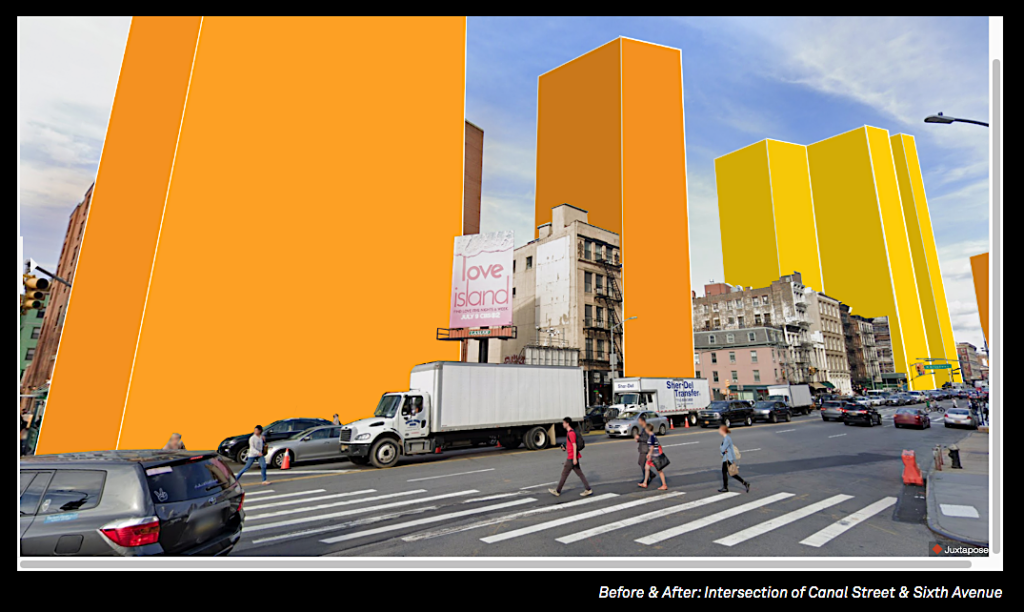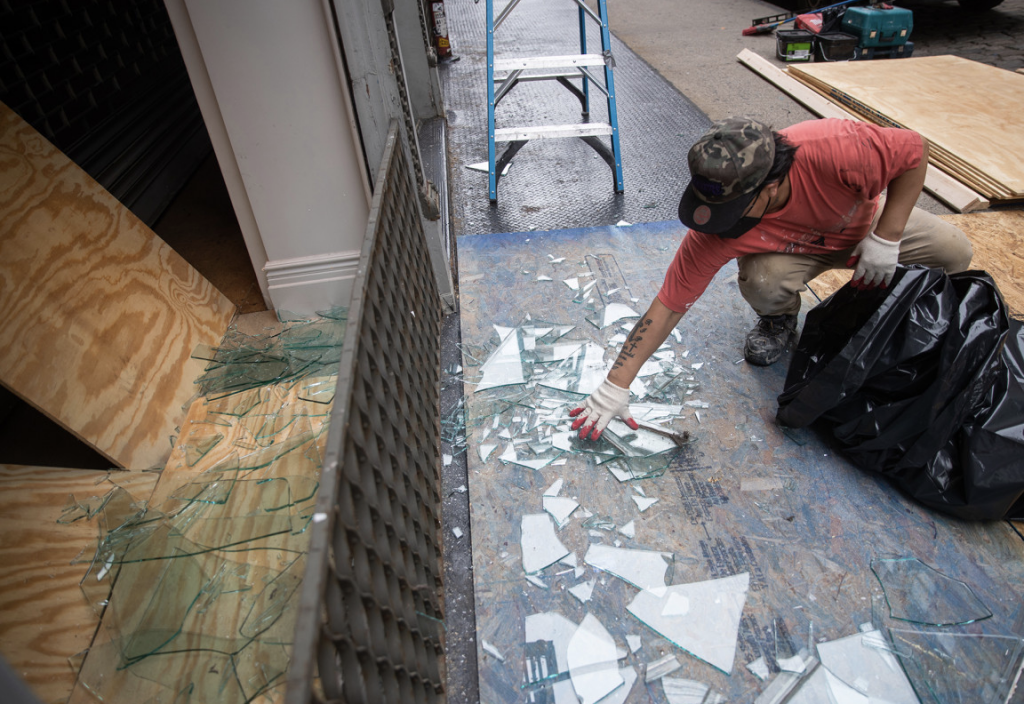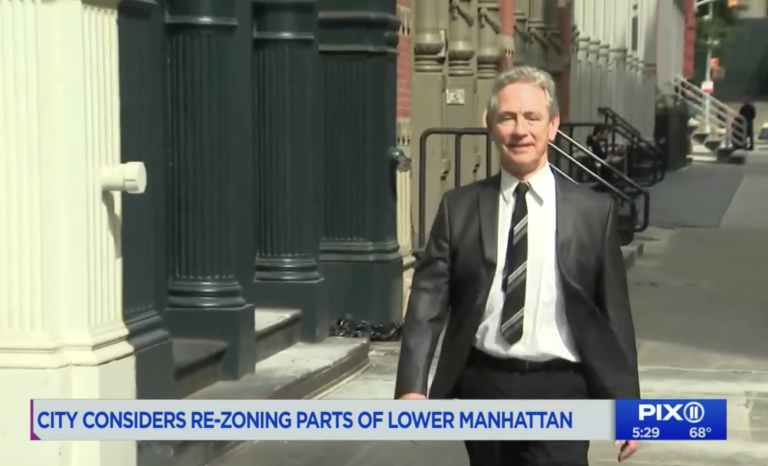December 16, 2023
‘We are the majority!’
E-bike safety group pushes for hearing on Holden licensing bill
DECEMBER 15, 2023
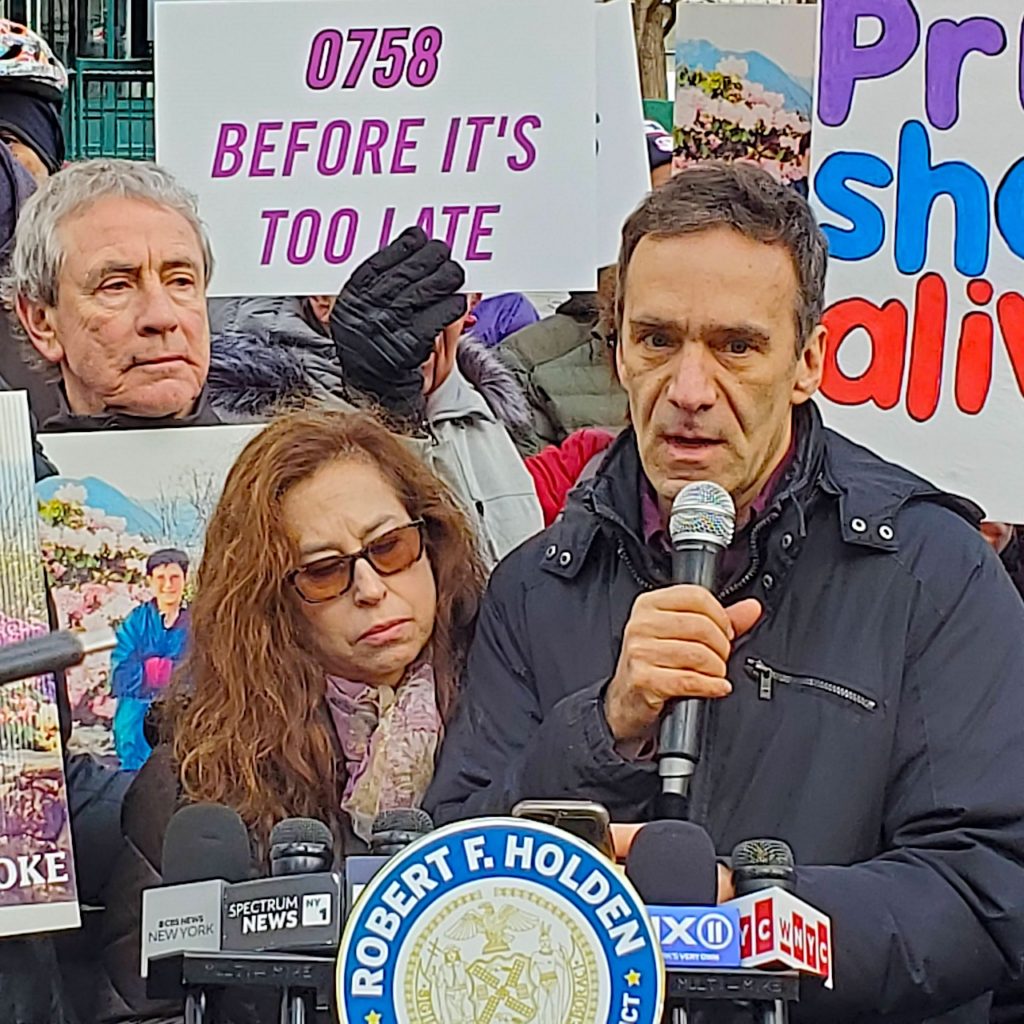
Cellist Pamela Greitzer-Manasse, left — with her husband, Jon Manase, at the EVSA press conference — was crossing on a green light outside Lincoln Center in July 2022 when she was hit by an electric moped zooming off of a sidewalk median. She was left with titanium plates in her skull, partial right-side paralysis and can no longer play her instrument. Police let the scooter rider — who initially tried to flee — go, claiming they could do nothing. (Photo by The Village Sun)
BY LINCOLN ANDERSON | It was a blustery day last week when councilmembers and New Yorkers demanding “accountability” for e-bike riders rallied outside City Hall. Despite the chill, they were fired up by the hope that a bill requiring all e-bikes to sport license plates could be passed before the end of the year.
Bill No. 0758-22, introduced by Councilmember Robert Holden, until recently had 34 co-sponsors, which, according to advocates, was enough to force a City Council hearing on the measure. However, after allegedly being pressured by cycling advocates, two of the councilmembers — Sandy Nurse and Rita Joseph — withdrew their support.
Holding a hearing before year’s end is significant because, if it doesn’t happen, the bill would then need to be reintroduced in 2024 and co-sponsors would need to be rounded up all over again.
However, earlier this week, Councilmember Carlina Rivera told The Village Sun her understanding is that Holden’s 0758 would not have a hearing this year. She explained that the last City Council “stated meeting” of 2023 is set for Dec. 20 and that, per usual procedure, councilmembers recently met to preview its agenda items. Holden’s bill is not listed on the agenda, she said. She confirmed that the bill would need to be reintroduced in the new year and co-sponsors collected all over again.
Rivera, however, does not back Holden’s bill.
“I think that licensing all the bikes would be really hard,” she explained.
Instead, Rivera said, she and Councilmember Gale Brewer would be introducing their own bill on regulating e-bikes.
The East Village politician added there are “a couple of bills” on e-bikes at the state and city level that could help address the situation. She said she also supports licensing mopeds at the point of sale.
Similarly, Christopher Marte, who represents Lower Manhattan, does not support Holden’s bill, although Erik Bottcher, whose district covers the Lower West Side, does.
Nevertheless, leading members of the new ad hoc group NYC E-Vehicle Safety Alliance (EVSA), remain confident they will get their desired hearing — if not this year, then the next. They say license plates are a must since e-bike, as well as e-scooter riders often flee after striking pedestrians.
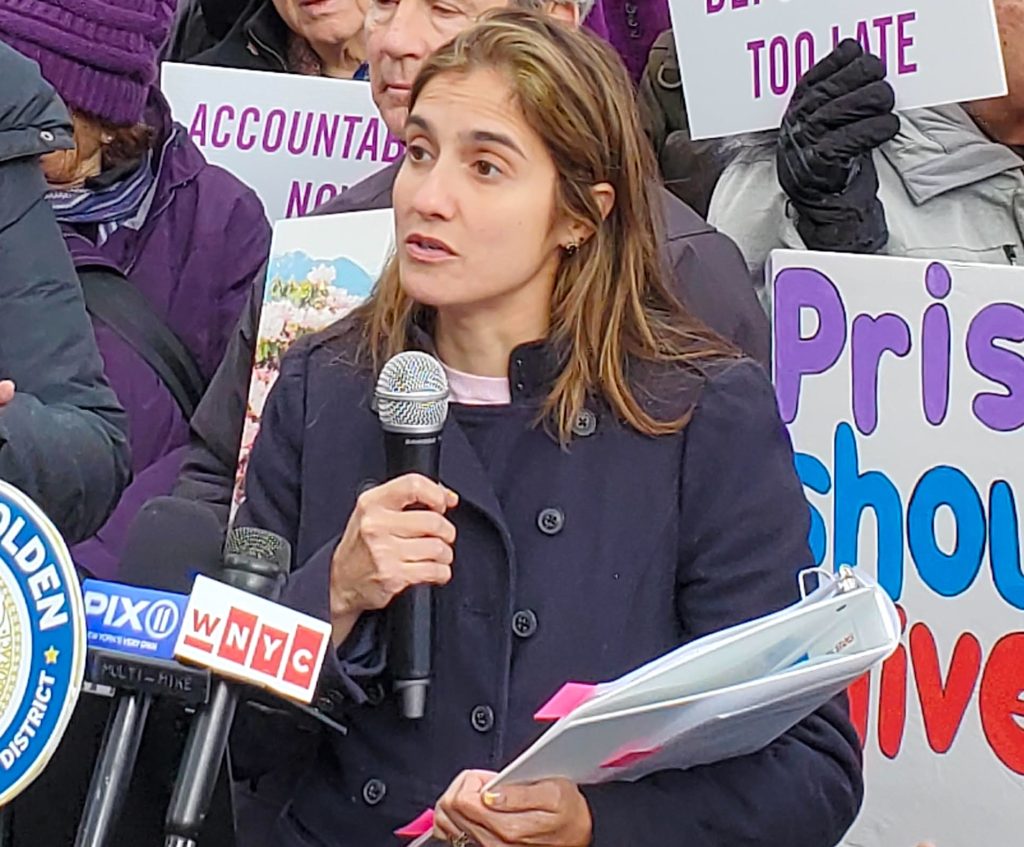
Councilmember Marjorie Velazquez, who represents part of the Bronx and previously overcame serious injuries from a car crash, was an early supporter of Bob Holden’s bill. Velazquez lost her election but her Republican successor, Kristy Marmorota, reportedly is supportive of the legislation. (Photo by The Village Sun)
Told of Rivera’s statement, Janet Schroeder, an EVSA co-founder, said her coalition of advocates and e-vehicle collision victims believe they will “prevail.”
“Bob Holden’s bill has 32 co-sponsors of the 51 possible councilmembers and that is very good,” she said. “This includes councilmembers from across the political spectrum. We did have 34 co-sponsors, which is the ‘supermajority’ and automatically earned us a hearing on this bill. But, Transportation Alternatives, a bike lobbying group, wrote to councilmembers and asked them to not support this commonsense bill that will ultimately save lines and mitigate injuries, and we lost two co-sponsors because of their letters. It is disappointing because we are the voice of the majority. Legislators should listen to the majority of New Yorkers over the well-funded few. After all, isn’t this is a democracy where the many should lead the few?
“But we believe,” Schroeder said, “that we will prevail for Priscilla Loke and all of the victims killed or injured by e-bikes.”
Similarly, Andrew Fine, another EVSA co-founder, voiced confidence that a hearing will happen sometime soon.
“The chairperson of the Transportation Committee, Selvena Brooks-Powers, could call a hearing whenever she wants, regardless of the number of co-sponsors, but claims that there is not enough time left in the year,” he noted.
“The two newly elected councilmembers that I spoke to, Susan Zhuang and Kristy Marmorota, both indicate support. We should be at the same level of support, more or less, in the new year. I do believe we will get our hearing early in the new year.”
Meanwhile, at the Dec. 6 EVSA press conference, e-bike collision victims shared their pain and frustration at what they called a crisis on the streets — and on the sidewalks. They slammed City Hall as unaccountable on the problem.
The crowd held signs saying, “Priscilla should be alive” and “0758 Before It’s Too Late.”
Lai noted that “for 15 days, [Loke’s] family and friends had no idea [who the] killer” was as police tried to track down the cyclist — after officers let him go at the scene without recording his personal information.
“Chinatown Head Start strongly requests the City Council to pass the law which requires all e-bikes to be registered and licensed,” she said. “At a minimum, the victim and the families need to know who the e-bike drivers are. They need to be held accountable for the accident they cause.”
Another woman was seriously injured on Sept. 15 in Murray Hill when she was hit by an e-Citi Bike going the wrong way in the bike lane at 38th Street and Second Avenue. The last word from police was that she was in a coma. The cyclist has not been found.
Sarah Pratt, originally from England, related her ordeal of being rammed from the rear by an electric Citi Bike as she walked on a sidewalk in Harlem.
“I was catapulted from behind,” she said.
As she told it, the cyclist then turned around only to berate her, shouting, ‘What the f—?’”
Pratt said she called Citi Bike to report the incident but was told, “Citi Bike is not responsible for any accidents once a bike is hired.”
Noting it’s illegal for anyone above age 12 to bicycle on a New York City sidewalk, she fumed, “My assailant should have learned the rules of the road before he ever got an e-bike.
“Many New Yorkers are more afraid of being hit by an e-vehicle than being hit by a car,” Pratt said. “New Yorkers will be left with no option but to seek legal action against New York City, Grubhub, Citi Bike and the manufacturers of illegal e-bikes.”
Another collision victim, Carol Wilson, noted she was hit not once but twice by e-bikes, the first time causing a skull fracture, vertigo for a year and the inability to read for two and a half years. Making it even more dangerous for her, she’s on blood thinners. The second time she was hit on Sixth Avenue. Fearful of being hit again, she now pays a fare to use a subway tunnel to cross under the avenue.
After the first hit, Wilson asked a detective if police would find the rogue cyclist, but he told her, “Probably not. Citi Bike does not cooperate with police.”
“I used to enjoy walking around New York City,” she said. “But now I know, leaving my apartment, my life is in danger.”
Sean Sweeney, the director of the Soho Alliance, echoed the cry of EVSA’s leaders in demanding that City Hall listen to “the majority” on the e-bike issue.
“I see people from all over the city wanting to register e-bikes,” Sweeney said. “When are the mayor and the so-called commissioner of the Department of Transportation going to listen to — not the lobbyists and Transportation Alternatives — but the majority!”
“Hearing now! Hearing now!” the crowd chanted.
Upper West Side speakers were not only unhappy Councilmember Gale Brewer won’t support Holden’s bill, but that she also backs siting an e-bike battery charging station at the hectic intersection of 71st Street and Broadway, where Broadway and Amsterdam Avenue crisscross and a heavily used subway station is located. EVSA’s Fine worried that a bad battery could explode in the charging station and send “shrapnel” shooting into the crowded crossroads.
“Gale Brewer is working against my bill,” Holden declared toward the rally’s end. “I couldn’t believe it.”
“We feel being against this bill is ageist and ableist,” Schroeder added.
Unlike Councilmember Rivera, Allie Ryan, a former political candidate who has run against her twice, said she’s all for 0758.
“We need to pass Bob Holden’s bill,” she said. “I 100 percent support it.”
In related news, Priscilla Loke’s friends, family and supporters were denied a full sense of closure after a mixup deprived them of knowing when the cyclist who fatally struck her would give his plea before a judge in Traffic Court. According to a source, a police Traffic Division detective had been in touch with a family member, pledging to let him know the court date. Yet, for some reason, the detective then chose not to call or text from his cell phone — which he had always done before — but from an office phone number the family member did not recognize.
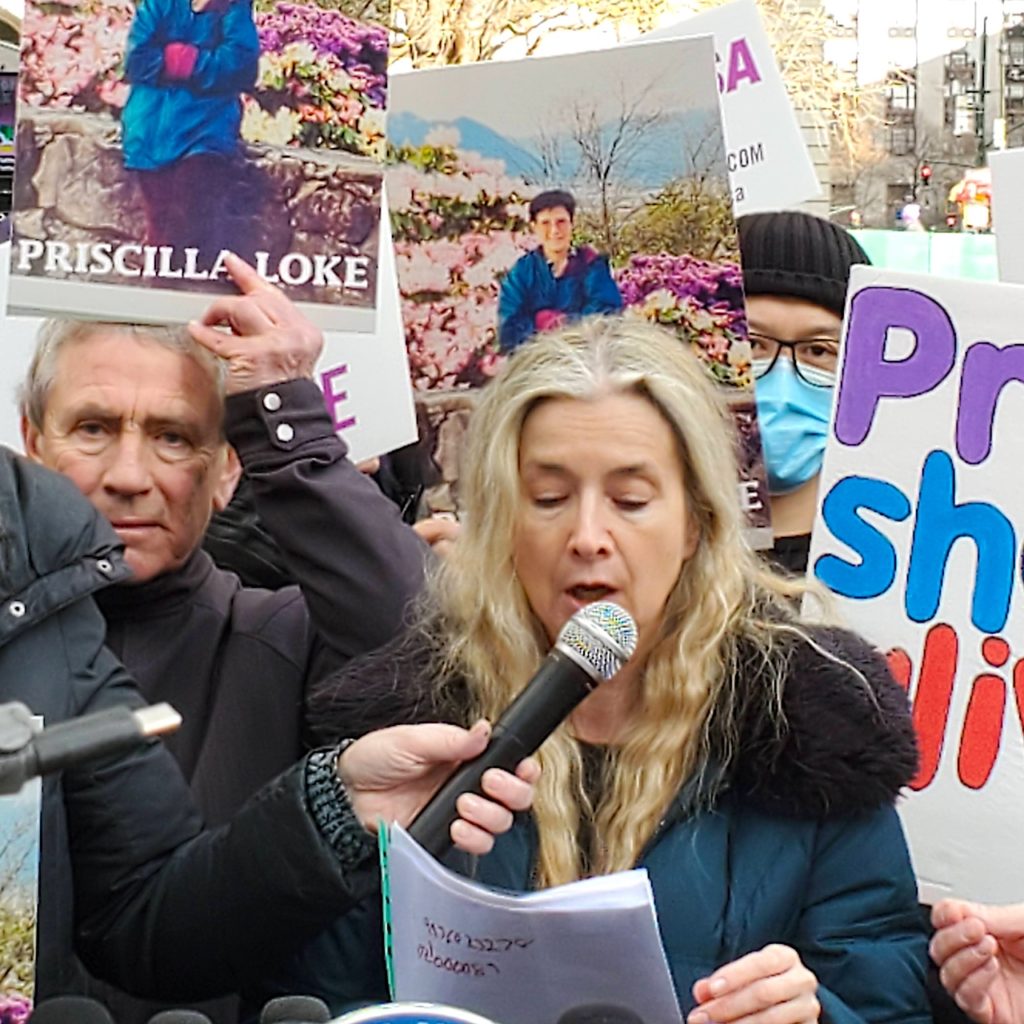
Sarah Pratt said there was no accountability after she was “catapulted” into the air by an e-Citi Bike rider on the sidewalk in Harlem. (Photo by The Village Sun)
“Priscilla should be alive” and “0758 BEFORE IT’S TOO LATE,” read signs in the crowd.
Another woman was seriously injured on Sept. 15 in Murray Hill when she was hit by an e-Citi Bike going the wrong way in the bike lane at 38th Street and Second Avenue. The last word from police was that she was in a coma. The cyclist has not been found.
Sarah Pratt, originally from England, related her ordeal of being rammed from the rear by an electric Citi Bike as she walked on a sidewalk in Harlem.
“I was catapulted from behind,” she said.
As she told it, the cyclist then turned around only to berate her, shouting, ‘What the f—?’”
Pratt said she called Citi Bike to report the incident but was told, “Citi Bike is not responsible for any accidents once a bike is hired.”
Noting it’s illegal for anyone above age 12 to bicycle on a New York City sidewalk, she fumed, “My assailant should have learned the rules of the road before he ever got an e-bike.
“Many New Yorkers are more afraid of being hit by an e-vehicle than being hit by a car,” Pratt said. “New Yorkers will be left with no option but to seek legal action against New York City, Grubhub, Citi Bike and the manufacturers of illegal e-bikes.”
Another collision victim, Carol Wilson, noted she was hit not once but twice by e-bikes, the first time causing a skull fracture, vertigo for a year and the inability to read for two and a half years. Making it even more dangerous for her, she’s on blood thinners. The second time she was hit on Sixth Avenue. Fearful of being hit again, she now pays a fare to use a subway tunnel to cross under the avenue.
After the first hit, Wilson asked a detective if police would find the rogue cyclist, but he told her, “Probably not. Citi Bike does not cooperate with police.”
“I used to enjoy walking around New York City,” she said. “But now I know, leaving my apartment, my life is in danger.”
Sean Sweeney, the director of the Soho Alliance, echoed the cry of EVSA’s leaders in demanding that City Hall listen to “the majority” on the e-bike issue.
“I see people from all over the city wanting to register e-bikes,” Sweeney said. “When are the mayor and the so-called commissioner of the Department of Transportation going to listen to — not the lobbyists and Transportation Alternatives — but the majority!”
“Hearing now! Hearing now!” the crowd chanted.
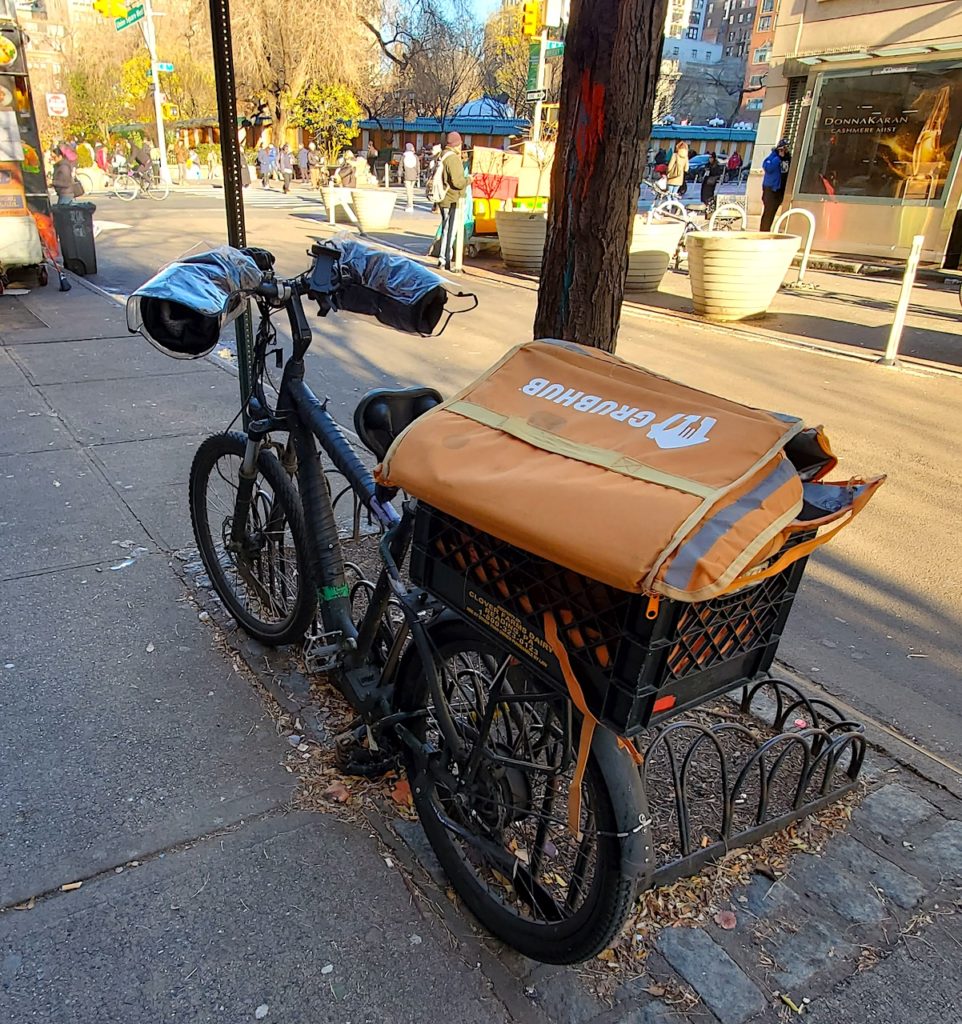
Lorem ipsum dolor sit amet, consectetur adipiscing elit. Ut elit tellus, luctus nec ullamcorper mattis, pulvinar dapibus leo.
Upper West Side speakers were not only unhappy Councilmember Gale Brewer won’t support Holden’s bill, but that she also backs siting an e-bike battery charging station at the hectic intersection of 71st Street and Broadway, where Broadway and Amsterdam Avenue crisscross and a heavily used subway station is located. EVSA’s Fine worried that a bad battery could explode in the charging station and send “shrapnel” shooting into the crowded crossroads.
“Gale Brewer is working against my bill,” Holden declared toward the rally’s end. “I couldn’t believe it.”
“We feel being against this bill is ageist and ableist,” Schroeder added.
Unlike Councilmember Rivera, Allie Ryan, a former political candidate who has run against her twice, said she’s all for 0758.
“We need to pass Bob Holden’s bill,” she said. “I 100 percent support it.”
In related news, Priscilla Loke’s friends, family and supporters were denied a full sense of closure after a mixup deprived them of knowing when the cyclist who fatally struck her would give his plea before a judge in Traffic Court. According to a source, a police Traffic Division detective had been in touch with a family member, pledging to let him know the court date. Yet, for some reason, the detective then chose not to call or text from his cell phone — which he had always done before — but from an office phone number the family member did not recognize.
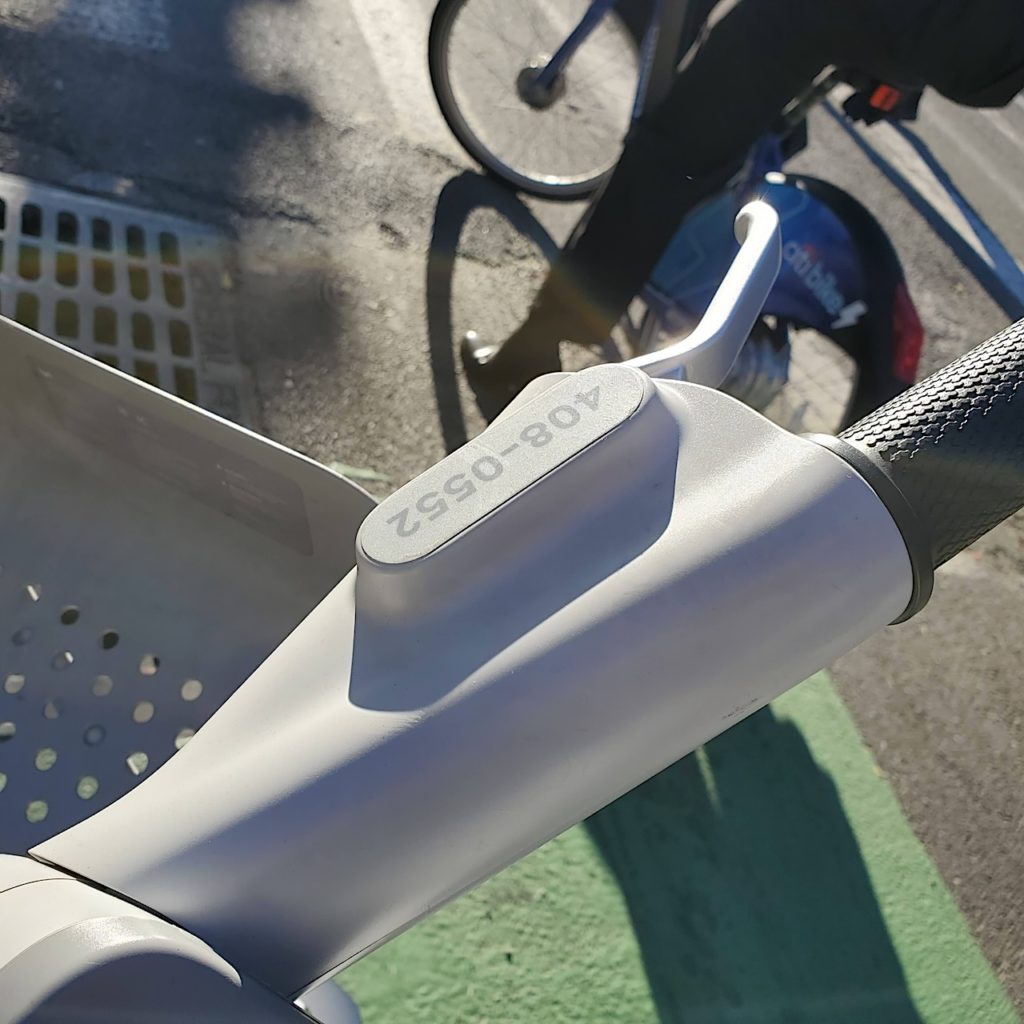
E-Citi Bikes do have ID numbers on their handlebars and seat posts — but it’s not the same thing as a clearly visible license plate, advocates contend. (Photo by The Village Sun)
The Citi Bike e-cyclist, who remains unidentified to the public, on Nov. 17 pled guilty in court to running a red light and was slapped with the maximum penalty — a $200 fine. Also, his driver’s license was suspended for 90 days — yet, galling Loke’s family and friends, there was no prohibition against him riding electric Citi Bikes.
“So, technically, he could be on the street riding an e-bike now,” noted Liz OuYang, a civil rights attorney and friend of Loke.
“Very, very disappointed,” OuYang said of the failure to adequately notify the family about the court date. “We would have packed the courtroom. The officer did claim he reached out. But he didn’t take affirmative steps to confirm the family was aware of the court date. He should have made additional effort. The officer said repeatedly he would notify the family.”
The attorney stressed that all e-bikes need clearly visible license plates — even Citi Bikes, which admittedly have small ID numbers on them already.
“We don’t want Priscilla’s death to be in vain,” she said. “The law needs to be changed — and it begins with e-bikes being licensed.”

April 30, 2023
Under the Arch
‘Manifest destiny’: NYU’s history of expansion in Washington Square
Throughout its nearly 200 years as a university, NYU has been in a constant state of expansion. Its plans for growth have changed drastically over time.

Carmo Moniz, News Editor | Apr 30, 2023
As you walk through Washington Square Park, the unofficial center of all goings-on at NYU, it’s impossible to miss the dark red sandstone of Bobst Library’s exterior, the towering Kimmel Center for University Life building, or the scattered purple flags hanging off of more buildings than you can count.
It’s hard to imagine the park or Greenwich Village without an NYU building at every corner, but just over 50 years ago, many of these now staples of the university did not yet exist.
When NYU was founded, in 1831, the university had no presence in Washington Square, and wouldn’t until four years later. Its first building on the Square, the University Building, was located on the east side of the park, and contained academic facilities, as well as apartments on its upper floors. The building has since been demolished and rebuilt once, and renamed twice, and is now the Silver Center for Arts and Science.
NYU now owns more than 70 buildings in the Greenwich Village area, the result of over a century of expansion. During its time in Washington Square, the university has seen some of the most quintessential moments in the neighborhood’s history, from a 1917 declaration of the park as an independent republicto the community’s fight against Robert Moses’ plan to run a highway through the park in the ’50s.
The university’s decades-long presence has made it an integral part of the neighborhood, but its expansion efforts have often clashed, with opposition from artists and longtime residents of the neighborhood.
In a 1985 WSN article titled “‘Grave’ beginnings for Washington Square Park,” writer Pierre Haddad reflected on the park’s history and the university’s growing presence around it. Haddad chronicled the Village’s journey, from a mass burial ground in the late 1700s to a haven of picturesque houses and gardens, to a space for offices, factories and boarding houses occupied by Bohemians.
“Washington Square regained its earlier character by the 1920s as the years pushed the limits of the city ever northward,” Haddad wrote in the article. “The area around the Square has since remained a symbol of continuity between past and present, characterized by its Gothic and Greek houses standing side by side with NYU’s modern ‘Redskins’ such as Bobst Library and Tisch Hall.”
‘An Urban Space Odyssey’: NYU’s vision for Washington Square in the ’60s and ’70s
In 1964, architects Philip Johnson and Robert Foster designed a plan for university buildings on the east and south sides of Washington Square Park, under the direction of James Hester, NYU’s 11th president. The design included plans for four red sandstone buildings reaching from Waverly Place to LaGuardia Place, where Bobst Library, Tisch Hall, the Silver Center, Goddard Hall and the Steinhardt School of Culture, Education, and Human Development now stand.
According to a 1977 WSN article, titled “NYU’s Master Plan: An Urban Space Odyssey,” the plan also included an arched glass structure between what are now the Silver and Steinhardt School buildings. The glass arch, named the “galleria,” was inspired by Italian designs, and was equipped with air conditioning.
William Payne, a former NYU spokesperson, told WSN in 1977 that the university had not abandoned the 1964 plan — it was meant to give NYU a design concept and was created to be adjusted.
“Philip Johnson designed an ultimate NYU,” Payne said. “Money considerations made some plans impossible, but can’t you have a dream?”
One of Hester’s most significant contributions to NYU’s campus was Bobst Library, though the project faced stark opposition from local residents at the time.
In the 1977 article, WSN editor Brian Huggins wrote that residents were concerned that the building would block the open space between Houston Street and Washington Square Park. The opposition caused construction to be delayed by a year. In July 1966, the university was able to go forward with plans for the library, and it was completed in 1973.
“Local residents claimed the 150-foot cubic structure would cast a shadow on the park and destroy whatever aesthetic appeal Washington Square had left,” Huggins wrote. “Residents in Washington Square Village claimed the monolith would obstruct their view.”
The same year that Bobst was built, the university made the decision to sell its undergraduate campus in the Bronx, which it had opened in 1894, due to financial hardship. The space, which NYU previously considered its main campus, was acquired by Bronx Community College.
As a result, the ’70s saw Washington Square become the center of the university, where, according to NYU spokesperson John Beckman, there were few dorms and no central library. Beckman said that the university then embarked on a decades-long development plan, in which it built new residence halls, repurposed existing buildings for teaching and laboratory uses and obtained housing for faculty.
“Broadly speaking, the NYU that we know today started in the early 1970s,” Beckman said. “The then-board of trustees and the senior leadership of the university made an important strategic decision: to transform NYU from a good regional university into a strong, highly selective, top national research university.”
Hester’s additions to the Washington Square campus had followed a number of developments that came after many factory lofts and residences south of the park were demolished by the city in the ’50s, according to Huggins. What came after was an increase in student and faculty housing on campus.
As more students moved into the Village to attend NYU in the ’80s, ’90s and 2000s, many residents were displaced, according Andrew Berman, the executive director of the nonprofit Village Preservation.
“When it built those huge dorms on Third Avenue and the East Village, that had a secondary effect,” Berman said.
In 1959, NYU completed a graduate and faculty housing development called Washington Square Village, which now houses more than 1,000 families. Only eight years later, it finished building the three buildings that make up the Silver Towers development, two of which house students and faculty.
Another project, the 14-story Warren Weaver Hall, was completed the year after Hester took office. Loeb Student Center — which the Kimmel Center has since replaced — and Weinstein Residence Hall had been built under his predecessor, Carroll Newsom.
Joseph Roberto, who was formerly NYU’s official architect, said that future university construction near Washington Square would focus on improving already existing buildings.
“Considering the world you’re faced with, you have to have imagination and far-fetched ideas to attract publicity and attention,” Roberto said in the 1977 article. “Even though the galleria was beyond our means and no one had serious thoughts of constructing it, it served the purpose because it showed NYU had ideas and a master plan.”
NYU’s $6 billion expansion plan and the Greenwich Village community
In 2007, another plan for NYU development was announced, although this time with a projected 6-million-square-foot expansion. John Sexton, the university’s 15th president, wrote in a letter that the plan, called NYU 2031, was meant to ensure that the university’s facilities could keep up with its growth.
The project also envisioned NYU spaces in Brooklyn and on Governors Island, but the largest part of the expansion — which included 3 million square feet of construction — was to take place in Greenwich Village. Like other expansion projects before it, the 2031 Plan was met with opposition from Village residents, but the backlash was on a larger scale.
One of the project’s biggest opponents came from within NYU. Faculty Against the Sexton Plan, a group of around 400 professors, were vocal critics, saying that it would increase tuition costs and that it disregarded faculty input. In 2008, two years before the plan was announced, the university had said that it would raise tuition and cut jobs to fund its expansion plans.
By April 2012, 23 faculty departments had passed resolutionsagainst the plan. Andrew Ross, a professor of social and cultural analysis who was involved in Faculty Against the Sexton Plan, said that many students were also against the plan, and that it faced so much opposition because it was mostly planned by the administration, not faculty or the surrounding community.
“The only people that were not against it was the NYU administration,” Ross said. “You want to ask yourself, ‘Well, why does the university have to be continually expanding in this way? What is the purpose of that expansion? What is the purpose of that growth?’ It doesn’t have to grow in that way.”
Berman, the Village Preservation director, said that in his 30 years of working on the issues between NYU and the Village community, he has found that residents’ biggest complaint against the university has been that it is misleading in its communication about development plans.
“John Sexton and the NYU 2031 Plan pretty much destroyed the university’s relationship with the surrounding community, and it’s never been repaired since, at least in terms of administration and leadership,” Berman said. “It was a kind of scorched earth policy, where they really burnt that bridge and have made no efforts to repair it since then.”
At the heart of the 2031 Plan were two superblocks enclosed by West Third Street, LaGuardia Place, Houston Street and Mercer Street. NYU proposed constructing four new university buildings on the blocks, one of which would become the present-day Paulson Center.
The plan was unanimously rejected in February 2012 by Manhattan Community Board 2, which represents Greenwich Village and other downtown neighborhoods.
During the approval process for the plan, NYU received a number of recommendations from a community task force that included members of Community Board 2. The recommendations were intended to ensure that the 2031 Plan took the well-being of the community into account. Some of the recommendations were that NYU make an effort to decentralize its development, take the character of other buildings in the Village into account in the design for new buildings and seek community input.
According to former Community Board 2 member Sean Sweeney, however, NYU did not listen to many of the task force’s suggestions.
“NYU is a real estate development corporation disguised as a university,” said Sweeney, who is the director of the community advocacy group SoHo Alliance.
Beckman, the university spokesperson, said that a number of changes to the project during the land use review process, including reducing the height of all four buildings on the superblocks, directly addressed the community board’s concerns. He said NYU did not, however, agree that it should be prohibited from expanding on the superblocks, which it has owned for decades.
After it was rejected by the community board, the 2031 Plan’s area was reduced by 370,000 square feet. In July 2012, it was approved by the New York City Council. The university faced a number of lawsuits after the approval, including one from various community groups and another from residents of Washington Square Village. The first lawsuit restricted the space in which NYU had city approval to expand, and the second was dismissed.
The university later rebranded the 2031 Plan as the Core Plan, with the Paulson Center as its central focus. Currently, the university does not plan to revive any other parts of the original plan, according to Beckman.
“NYU’s space needs remain acute, notwithstanding the opening of the Paulson Center,” Beckman said. “However, at this point the university doesn’t have immediate plans for the other project sites identified under the Core Plan.”
James Russell, a journalist who writes about architecture who is a critic of the 2031 Plan, said the distrust the university built with the Village made it more difficult for it to expand.
“NYU cannot help but be the 800-pound gorilla in the neighborhood,” Russell said. “As an urban campus, it should simply seek graceful integration into its physical surroundings and more opportunities for the non-NYU community to engage with NYU people, not just to be good neighbors but as a way of leveraging New York City’s great attributes.”
A supermarket, the Village and the university
Years later, the 2031 Plan continues to affect Greenwich Village residents. A Morton Williams supermarket on Bleecker Street and LaGuardia Place, situated on a property owned by NYU, might be out of service for a few years due to an agreement the university made with the city, allowing it to build a public school on the lot.
The deal was made as part of the approvals process for NYU’s expansion plan, and set a deadline for the New York City School Construction Authority to decide whether to use the lot by the end of 2014. The deadline was twice extended, stretching until the end of 2021, and the SCA established a plan to build a school on the lot in November of that year. The university has once again extended the deadline for the SCA to decide if it wants the lot, leaving the future of the supermarket uncertain.
Avi Kaner, the owner and operator of various Morton Williams locations throughout the city, said that there are currently three possibilities for the supermarket’s future. The city could choose not to take the lot and allow the supermarket to stay, the university could provide the city with space for a school in future developments or the supermarket could share the site with the public school. Should the last scenario occur, the community will be left without a supermarket for at least three years.
“We are deeply engaged with NYU, the city, community groups and elected officials to ensure the supermarket is saved,” Kaner said. “There are only eight months left in the year for the city to decide on saving the supermarket.”
Karin Kiontke, a researcher in NYU’s biology department who used to live in graduate student housing near the market, said that she has been investigating the university’s role in the Village. For the last 17 years, she has been caring for LaGuardia Corner Gardens, a small community garden next to the Morton Williams. She said that if construction on the lot moves forward, the garden, which has existed since 1981, will likely be destroyed.
“We have been threatened by NYU since forever,” Kiontke said. “There’s this resistance of the community, and then they tell you this and they do something different.”
Kiontke said that while many residents don’t like the university’s presence, many restaurants and shops benefit from the patronage of the tens of thousands of students and faculty NYU brings to the Village. This has been the case since NYU began to focus on making the Washington Square campus residential. As NYU built more dorms and faculty housing, local businesses were provided with more and more customers.
A 1985 WSN article, titled “Boutique braces for NYU,” profiled Lynn Davidson, the owner of a clothing store at 309 E. Ninth St., where a gift shop now stands. Davidson said she was against the construction of the Alumni Hall and Third Avenue North dorms because she opposed the construction of high-rise buildings in the area. Despite this, she also said she hoped the future inhabitants of the student residences would shop at her store.
“There are two sides in me,” Davidson said. “There’s the old hippie, and there’s the businesswoman.”
Berman said that while there will always be issues between any university and nearby residents, NYU’s expansion has created an unresolvable tension within Greenwich Village.
“The problem is that the administration of the university has this ‘manifest destiny’ philosophy that it believes it should take over and become the controlling presence of more and more of the neighborhood,” Berman said. “It’s not that we think that the university or its presence is inherently bad, we only think it’s bad when it becomes the only presence in the neighborhood.”
About the Writer

Carmo Moniz is a sophomore majoring in journalism and politics in the College of Arts and Science. Shockingly, she’s really into political journalism and…
February 13, 2022

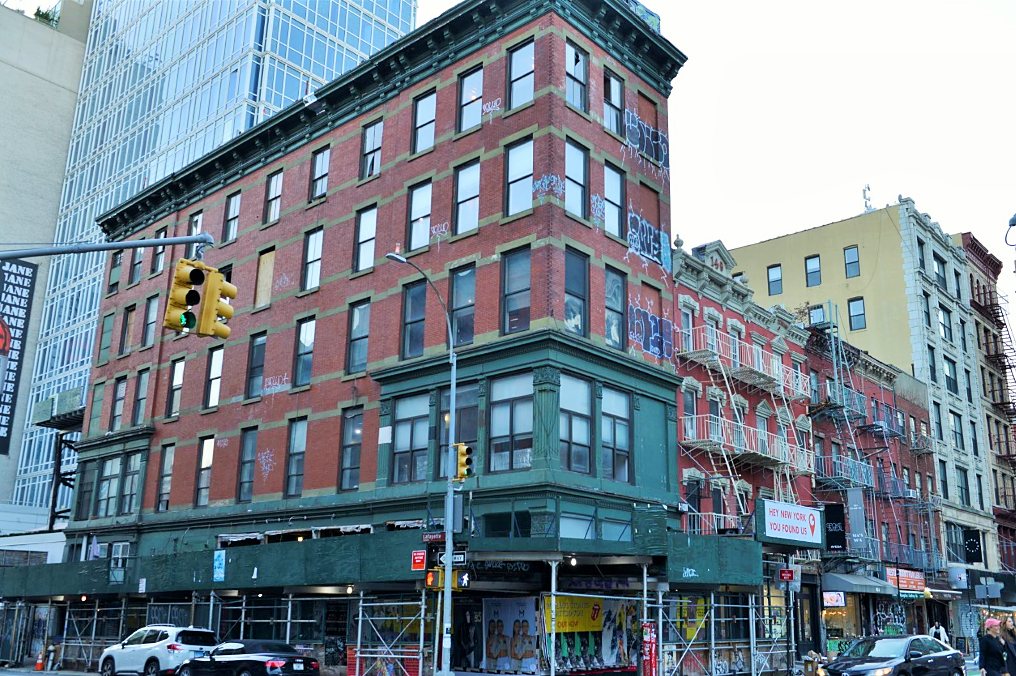
Constitutional challenge filed against Soho/Noho rezoning
BY LINCOLN ANDERSON | A lawsuit seeking to “annul and vacate” the Soho/Noho/Chinatown rezoning charges that the scheme would cause “mass displacement” of thousands of current neighborhood residents, as well as violate both the U.S. and New York State Constitutions.
On Thursday, the nonprofit Coalition for Fairness in Soho and Noho, along with 10 individual resident plaintiffs, filed suit in New York State Supreme Court against the Department of City Planning, the City Planning Commission, the City Council and Mayor Eric Adams over the rezoning, which became law in December.
The suit was brought by attorney Jack Lester.
The Village Sun first reported last month that the litigation was in the works.

January 3, 2022
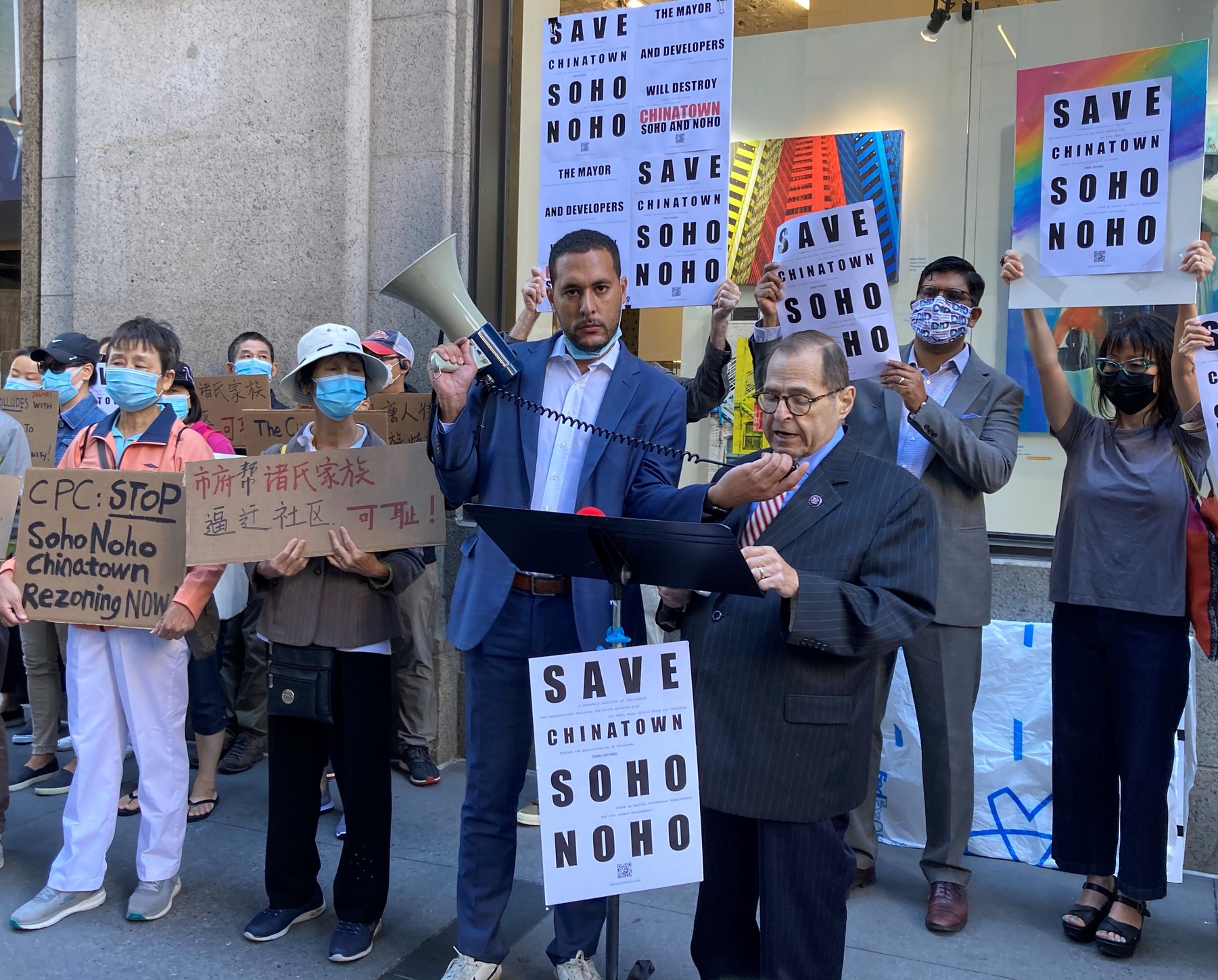
Christopher Marte, then the councilmember-elect for District 1, and Congressmember Jerrold Nadler spoke out against the Soho/Noho rezoning last September.
BY LINCOLN ANDERSON | As Yogi Berra once said, “It ain’t over till it’s over.”
A new ad hoc group has come together to challenge the Soho/Noho upzoning and is currently raising funds to mount a lawsuit.
The full City Council approved the rezoning on Dec. 15 at its final stated meeting of 2021.
Called the Coalition for Fairness in Soho and Noho, the new group’s GoFundMe Campaign, after just one month, had rapidly raised more than $136,225 toward its goal of $250,000 as of Sunday evening. This is listed as only “phase one” of the fundraising effort.

July 12,2021
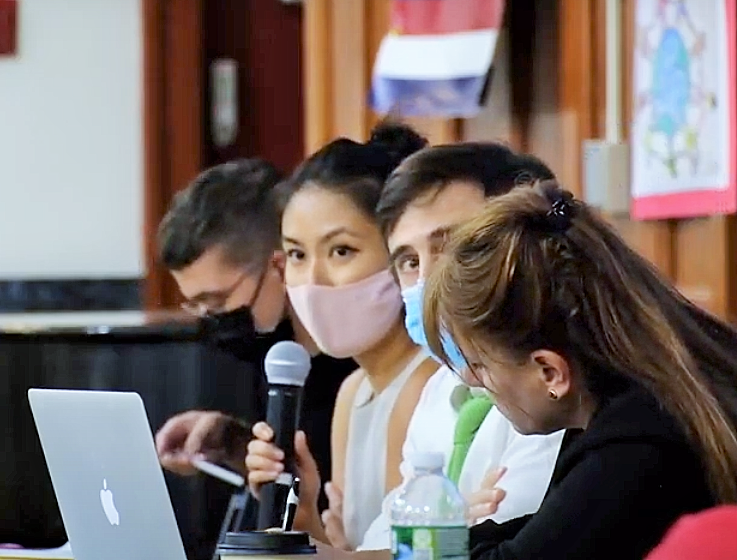
At a July 8 meeting on the Soho/Noho rezoning, a City Planning official cast a worried glance in the direction of a Downtown activist who had just shouted, “That’s an insult!” after Sylvia Li, speaking on the mic, called the Community Alternative Zoning Plan “magical thinking” and, basically, a fraud.
BY LINCOLN ANDERSON | Updated July 12, 1:00 p.m.: There may be a heat wave going on, but things got even hotter in Soho and Noho last week after a senior City Planning official accused rezoning opponents of only pretending to care about affordable housing.
Outraged community activists are now demanding that the planner’s remarks be “denounced and repudiated” and that “appropriate action be taken” against the woman and two of her colleagues who were at a meeting last Thursday where the comments were made.
The flap overshadowed the fact that, the day before, Justice Arthur Engoron of State Supreme Court had ruled against a community lawsuit seeking to block the city’s Soho/Noho rezoning plan. The plaintiffs had argued that the city did not give Community Board 2 sufficient advance notice of its intention to launch the public review of the rezoning, plus was “muting” the plan’s critics by holding meetings on Zoom instead of in person.
Initially, Justice Engoron had said that “insufficient notice is the same as no notice.” But last Wednesday, he reversed himself and declared in a terse ruling that “a notification doesn’t have to be perfect.”
In an e-mail after the verdict, Sean Sweeney, the director of the Soho Alliance, said, “We still have several options available and will be discussing our next move with our attorney this week.”
Meanwhile, at the C.B. 2 meeting on the Soho/Noho rezoning last Thursday, which was held in person, Christopher Marte, the Democratic nominee for City Council District 1, declared he opposes the scheme since it would displace existing residents, particularly low-income ones in the rezoning’s Chinatown area.
But right after Marte spoke, Sylvia Li, a senior planner with the Department of City Planning, lashed out at the Community Alternative Zoning Plan for Soho and Noho, which was created by Village Preservation and is supported by a dozen local community groups. The alternative plan supports increasing affordable housing in the two Downtown districts — but, unlike Mayor de Blasio’s rezoning scheme, does not rely on market-rate development to do so.
Li told the meeting that the alternative zoning plan “encourages people to engage in magical thinking that is not rooted in reality… . We think that is not a plan that is motivated by a genuine concern for displacement,” she said, “or…desire to introduce more housing affordability.”
“What? That’s insulting!” Todd Fine, president of the Washington Street Advocacy Group, blurted out in the audience as Li spoke.
In response, the dozen groups have signed on to a joint letter to City Planning, Borough President Gale Brewer and City Councilmembers Margaret Chin, Carlina Rivera and Corey Johnson, demanding that Li’s statements be “denounced and repudiated” and that “appropriate action” be taken against her, as well as Edith-Hsu Chen, the Manhattan director of City Planning, and the department’s counsel, who were also at the meeting.
In an interview with The Village Sun, Andrew Berman, the executive director of Village Preservation, slammed Li’s comments as both “despicable” and “ironic.”
May 14, 2021
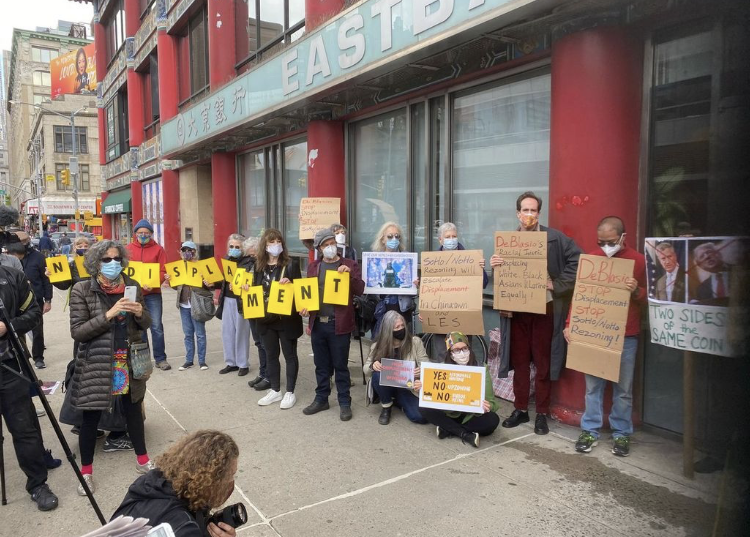
by Eddie Panta
Chinatown finds itself caught in a squeeze play with mega-towers set to loom over the Two Bridges neighborhood to its east and the rezoning of SoHo and NoHo to the west. As it turns out, Mayor de Blasio’s 11th-hour rezoning plan for the city’s historic districts will also include large swaths of Chinatown.
Yesterday, a coalition of community groups and tenant rights activists were joined by elected officials and political candidates at a rally-presser in Chinatown to protest displacement.
Chinatown Working Group, TenantsPC, Village Preservation –Broadway Residents Coalition, Soho Alliance, were together joined by candidates outside 183 Centre Street in Chinatown to demonstrate how owners of buildings like these would really be the ones benefiting from what they called a massive upzoning plan.
The SoHo/NoHo Neighborhood Plan, as City Planning officially calls it, would introduce the Mandatory Inclusionary Housing program at the expense of taller buildings. In other words, roughly 425 affordable housing units across both neighborhoods, but only if the SoHo historic district and the surrounding area, which now includes parts of Chinatown, were upzoned to include market rate and luxury housing.

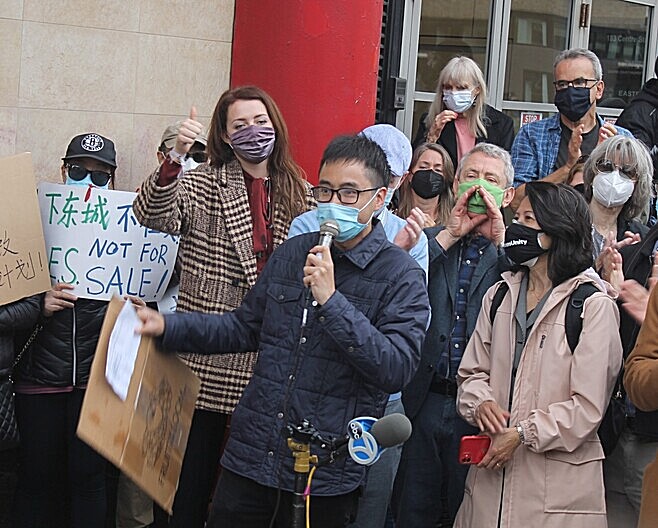
Zishun Ning of the Chinatown Working Group condemned the Soho/Noho rezoning for its “equality in displacement.” (Photo by The Village Sun)
MAY 11, 2021
BY THE VILLAGE SUN | Residents from all corners of Lower Manhattan rallied in Chinatown Monday to protest what they slammed as the mayor’s “fake social justice plan” for Soho and Noho and demand real protection against displacement.
The opponents warned that the proposed Soho/Noho rezoning — like Mayor de Blasio’s other rezonings — would benefit big developers and landlords, such as, in this case, Chinatown’s Chu family, who own multiple properties in the development area.
The rally was organized by the Chinatown Working Group and held in front of the Eastbank building, at 183 Centre St., near Canal St., a Chu property. In a blow to the community, the Chus recently closed Jing Fong, Chinatown’s biggest restaurant, which was unionized, putting 180 workers out of a job.
Many of the development sites identified in the mayor’s plan are on the border of Soho and Chinatown.
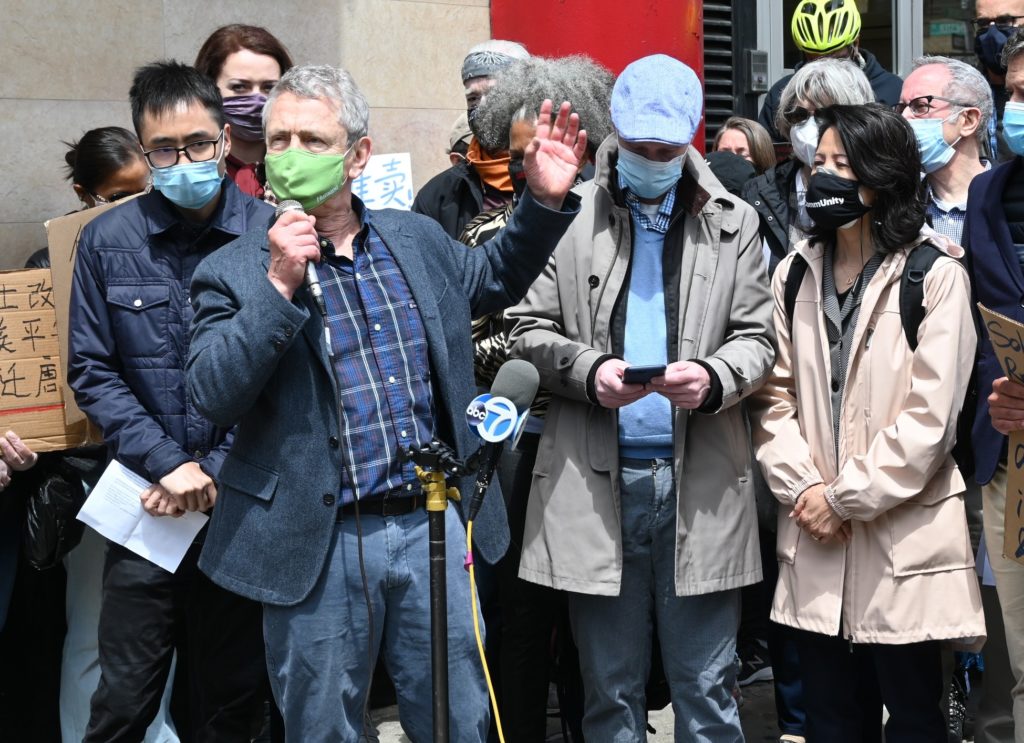
Sean Sweeney,director of the Soho Alliance, said real housing justice advocates, as opposed to “shills,” oppose the mayor’s plan. (Photo by Micki McGee)
The Eastbank building is right in a spot earmarked for some of the largest development under the Soho/Noho rezoning — development that the protesters warn would displace low- and moderate-income Asian residents and communities of color in the Lower East Side.


BY THE VILLAGE SUN | Neighbors from Chinatown to Soho will unite at a press conference Monday to condemn what they are decrying as the mayor’s “fake social justice plan” — a.k.a. the Soho/Noho rezoning — and instead demand real protection against displacement.
The rally will start at noon at 183 Centre St., at Canal St.
Participants will include members of the Chinatown Working Group, TenantsPAC, Village Preservation and Soho, Noho and Lower East Side community groups. They will demand that Mayor de Blasio stop his plan to upzone Soho, Noho and Chinatown and pass community-based plans like the Chinatown Working Group plan and the Community Alternative Rezoning Plan for Soho and Noho.
According to the protesters, contrary to the mayor’s misleading “social justice” portrayal of the plan, the Soho/Noho rezoning would escalate displacement across Lower Manhattan, especially in the communities of color of Chinatown and the Lower East Side.

Reversal of October 2020 plan after groups file lawsuit
May 9, 2021
Jason Cohen
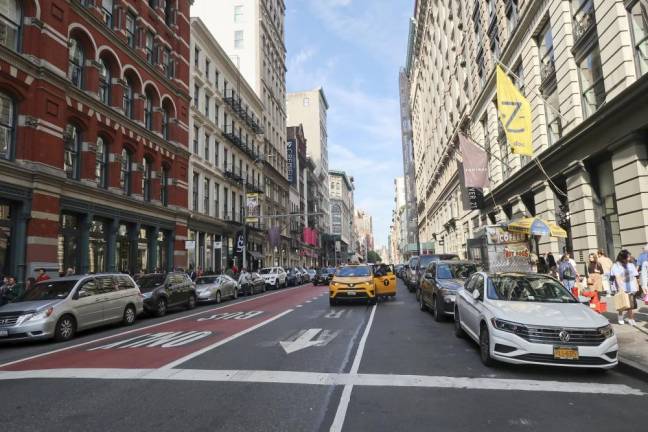
Soho street scene. Photo: Bex Walton, via Flickr
As community groups filed a lawsuit against plans to rezone Soho/Noho last month, things swung in their direction last week when City Planning declined to certify the rezoning.
It is quite interesting that on May 3, just three days after the petition was announced, that the city reversed its position.
Now, it seems what Mayor Bill de Blasio has been pushing for since October 2020 could be in trouble. The plan was designed to replace 50-year old zoning to offer more flexibility for businesses and arts and cultural organizations, while creating incentives for new affordable housing.
Sean Sweeney, director of the Soho Alliance, who filed the lawsuit with the Broadway Residents Coalition, couldn’t be happier about the news.
“The city tried to spin it that the judge denied our motion, a moot point by then, ignoring the fact that de Blasio has egg on his face with his pet project now stalled indefinitely,” Sweeney said in a letter to the community. “Whether it certifies then remains to be seen. The point is that the city realizes that it screwed up big time.”
May 2, 2021
BY LINCOLN ANDERSON | You don’t do ULURP right — you lose. And tightly controlled Zoom virtual sessions don’t constitute legally required in-person public meetings.
Those are the main arguments of Soho and Noho activists, who on Friday sued the de Blasio administration for ongoing “illegal orders and actions” and “blatant violations” of the City Charter as it pertains to the contentious Soho/Noho rezoning.
The litigation seeks a temporary restraining order and injunction to stop the Soho/Noho rezoning application process, warning that the city’s actions “present the threat of irreparable harm to the Soho and Noho population.”
The litigation seeks a temporary restraining order and injunction to stop the Soho/Noho rezoning application process, warning that the city’s actions “present the threat of irreparable harm to the Soho and Noho population.
April 9, 2021
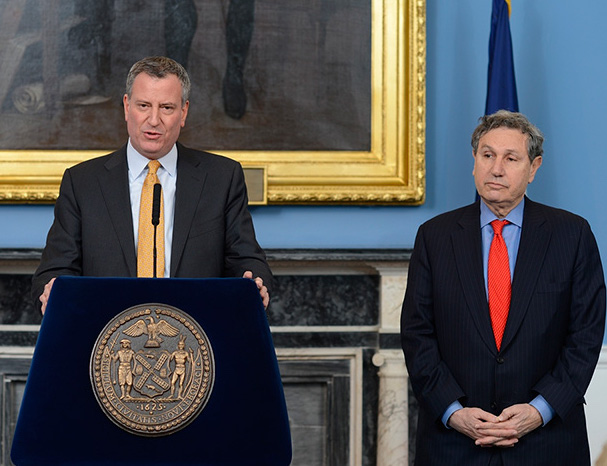
BY GERARD FLYNN
While the massive zoning recently announced for 56 blocks in the historic neighborhoods of Soho and Noho by Mayor de Blasio now calls for unprecedented development, the origins of the proposal date back to community concerns of a very different kind.
Under the plan, which the mayor surprisingly announced last fall, restrictions in the existing zoning on the size of ground-floor retail would be removed andan upzoning would be allowed under the mayor’s 2016 Mandatory Inclusionary Housing program, which trades increased density for 25 percent affordable housing. All of this is according to the mayor and his supporters in the name of equitable development, a term of the trade often bandied about by affordable-housing developers.
But residents of the neighborhood recently told The Village Sun the possibility of behemoth buildings rivaling those on Billionaires Row uptown was not their intention when they reached out to the offices of Councilmember Margaret Chin and Manhattan Borough President Gale Brewer in 2015.
They were simply asking for enforcement of the law curbing the influx of big-box stores spreading throughout the neighborhoods, which traditionally served industrial uses, but were rezoned M1-5A and M1-5B zoning districts in 1971 to allow for artists to live and work there under the Joint Live Work Quarters for Artists or JLWQA, which has since brought a flood of illegal conversions to luxury condos by occupants working in the financial sector.
“We were more than tired,” said Pete Davies, of Broadway Residents Committee,said. “It was making it such that we couldn’t sleep at night because of [all the overnight] deliveries.”
How it all began…
April 3, 2021
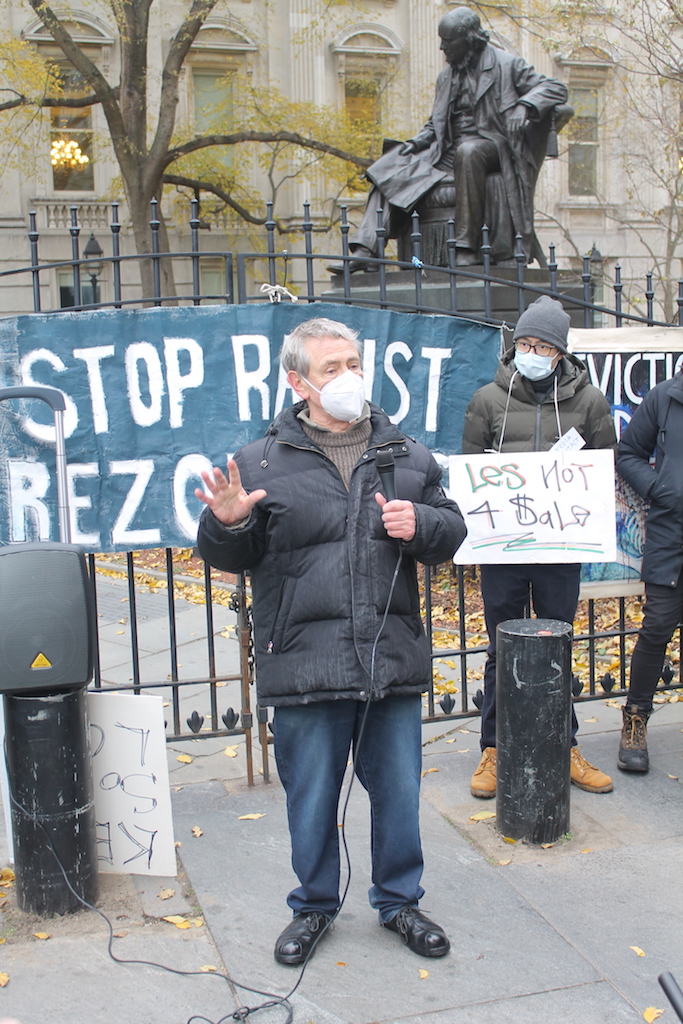
BY LINCOLN ANDERSON | Updated April 3, 6:30 p.m.: On Friday, the de Blasio administration announced that it has given 30-day notice to Community Board 2 that it is about to start the public review of the contentious Soho/Noho rezoning.
In other words, the rezoning plan would be “certified” in one month, allowing the process to move forward.
A tweet by the City Planning Department announced that the public review, known as ULURP, for the scheme will commence in May.
Digital Democracy ?
JanLeeNYC
Feb 4·4 min read
By Jan Lee
Public input is responsible for keeping New York City a desirable place to live and work, but the mayor’s new rules have prevented many residents from voicing their concerns about zoning issues that affect the livability of the city.
By holding virtual meetings to approve zoning issues in defiance of the laws surrounding the Uniform Land Use Review Process (ULURP), Mayor DeBlasio is changing the face of the city without hearing from the residents it affects most.
Residents have a different stake than developers and politicians when it comes to city planning. They know firsthand how overcrowded local schools are, the strain of public transit, and what a new warehouse, power plant or processing facility would do to their neighborhood.
By Michael Herzenberg Manhattan
Brooklyn-born Ben Schonzeit moved into a loft in SoHo nearly 50 years ago.
“I’m an artist. I’m a painter. I paint large paintings and I was looking for space to work in,” he explained.
He and his wife were among thousands of urban pioneers who began moving into the area starting in the 1960s for creative space.
What You Need To Know
- SoHo and NoHo are zoned for manufacturing and light industry with certified artists being allowed to live in “joint living work quarters for artists”
- An analysis by the Department of City Planning shows the Department of Cultural Affairs has granted as many as 5,760 artist certifications since 1971, but just 30 in the last five years and 68 in the five years before that
- Many residents technically live in SoHo and NoHo in violation of zoning rules. Because it’s a manufacturing zone, without special approval, retail is not allowed there either
- The mayor wants to fix the zoning rules to fit the current the neighborhood and also add as many as 3,200 housing units on 84 sites, of which 940 units would be affordable
“The space was cheap,” Schonzeit added.
It was a hub for manufacturing, but many of businesses started to leave after World War II. The influx of mostly artists chose to make the area a residential one, even though it was, and still is, zoned for manufacturing and light industry.
In 1971, the year they moved in, the state legislature voted to technically allow those engaged in fine arts to live in industrial loft buildings like the one into which Schonzeit moved. That same year the city started granting certifications and amnesties to artists in SoHo so they could legally live there. Several years later, NoHo was added.

An analysis by the Department of City Planning shows the Department of Cultural Affairs has granted as many as 5,760 artist certifications since 1971, but it’s unclear how many of the people still live and work in the neighborhood like Schonzeit.
“This is the room that I have spent most of my adult life in,” said Schonzeit, showing NY1 his art studio and some of his work.
He says he received one of those certifications decades ago so his living area and creative space are legal.
“I’m not allowed to live here because I’m not a certified artist,” real estate attorney Margaret Baisley said of her loft down the street.
She purchased the co-op decades ago and now says she keeps it empty until she can find an artist who qualifies as a renter.
She says the zoning here is too restrictive, causing financial stress.
“It’s incredibly expensive to maintain these buildings,” said Baisley.
Another example of the onerous zoning: for retail to be allowed on the ground floor, which helps pay for the building’s upkeep, it must go through a costly approval process.
“SoHo is known for retail and yet it’s astounding to tell people that retail is illegal unless you have a special permit or some other kind of dispensation,” Baisley said.
“We need zoning that meets the moment, not that’s 60 years old and very out of date for this neighborhood,” Deputy Mayor of Housing and Economic Development Vicki Been told NY1.
The Mayor’s Office has seized upon the need to rezone to add affordable housing.
It’s proposing changes that could add more than 3,200 housing units on 84 sites. Of those housing units, 940 would be affordable.
“We need affordable housing in every neighborhood across the city, especially in neighborhoods like this that offer enormous opportunities,” said Been.
“We were suckered into this by city planning,” said Sean Sweeney of the volunteer neighborhood group The SoHo Alliance.
He believes the Mayor’s Office agreed to update the the antiquated zoning in order to create more housing.
“What it’s gonna do is further gentrify SoHo. It’s gonna bring in 75% luxury housing. Don’t we have enough gazilionaires in SoHo?” asked Sweeney, rhetorically.
The city counters that in several public meetings over the previous year, affordable housing has been discussed and a quarter of the apartments would be reserved for people making less than the median income, from $41,000 to $82,000 a year for families of three.
“I think one of the great challenges of the city is many of the people who work here can’t live here,” said Schonzeit.
He wants to see his neighborhood become more affordable.
He is known as a Photorealist, but says his work now with collages, prints and sculptures looks more Cubist. He’s someone who obviously spends time focussing on aesthetics and is also concerned about the neighborhood’s character being lost with big modern buildings.

“I work in 12 different styles. I won’t do the same thing twice. I change all the time,” he said, adding, “and I’d like the rest of it to just stay in place.”

December 17, 2020
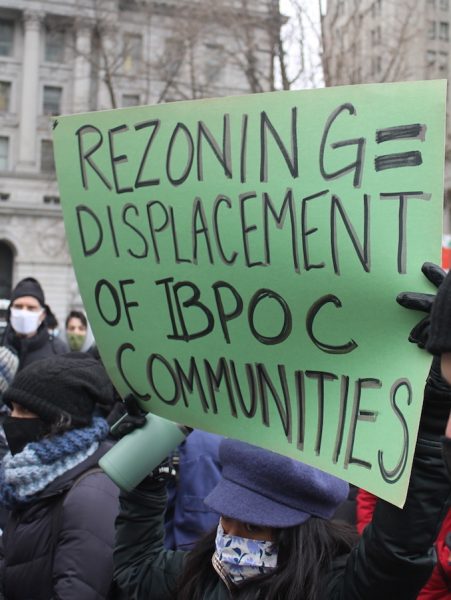
Community groups from around the city blasted Mayor de Blasio’s rezoning schemes as racist against indigenous and black people and people of color. (Photo by The Village Sun)
BY LINCOLN ANDERSON | Updated Thurs., Dec. 17, 6:30 p.m.: Soho and Noho may be only the latest battle, but New Yorkers have been fighting against Mayor de Blasio’s rezonings for years and across many different neighborhoods.
On Wednesday, community groups from around the city rallied right outside City Hall to declare, “Enough is enough!”
In the bitter cold, speaker after speaker charged that the rezonings — which inevitably always include an upzoning — are “racist” because they displace existing residents, who are almost always black and brown people. In effect, the rezoning plans, by flooding neighborhoods with market-rate housing, are gentrification on steroids, the speakers said.
Now, however, with de Blasio a lame duck and about to enter his last year in office, City Hall is making a final push to ram through as many of his rezonings as possible.
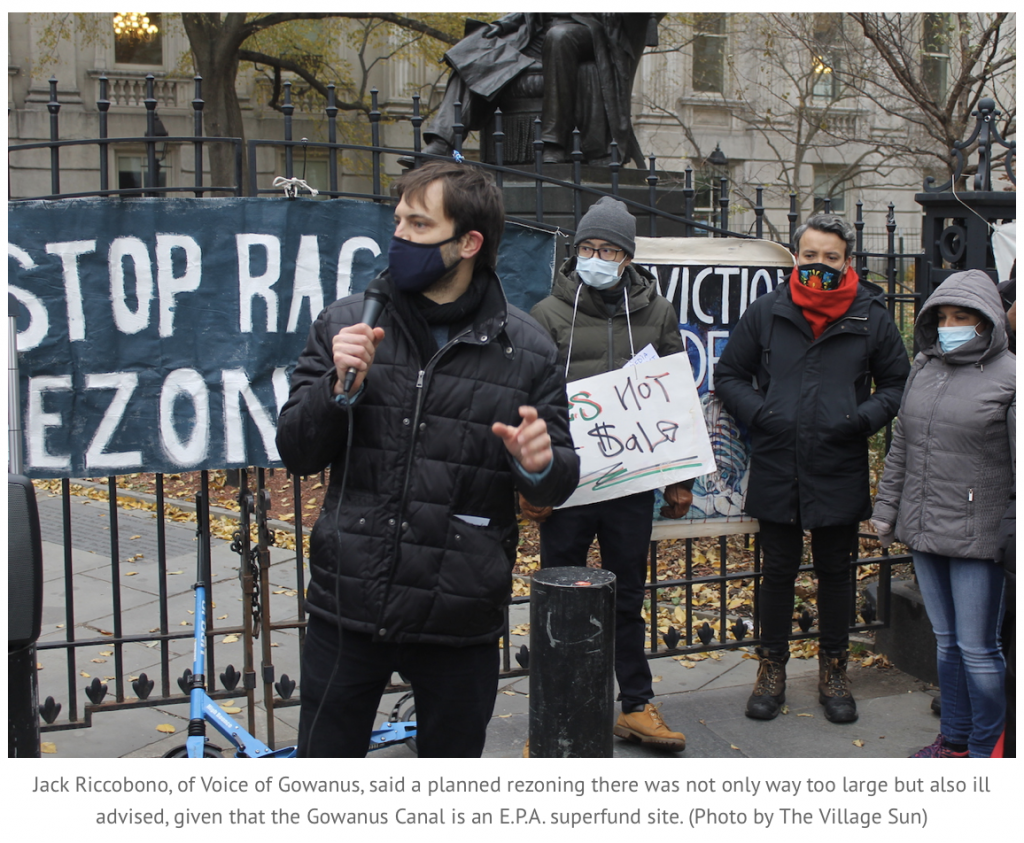
But in a “Community Declaration on the Future of New York,” the activists instead proclaim that it’s high time to “stop all rezonings [and] reinvent the rigged land-use process to allow for legitimate community-led planning instead of imposing ‘done deal’ developments.”
Their statement urges politicians, candidates and all New Yorkers to “reject the housing policy that is based on enormous giveaways to luxury real estate developers in exchange for a small percentage of dubiously named ‘affordable’ housing. Stop the use of ‘affordable’ as a safe word,” the statement says, “to justify towerization or as a substitute for real, multigenerational affordability for low-income people.”
Furthermore, their manifesto says, “No land-use review process should be allowed to use ‘virtual’ meetings — such as Zoom — as a substitute for public hearings.”
The statement is signed by 65 organizations, from 9th St. A-1 Block Association, Lower East Side Dwellers and South Village Neighbors to Crown Heights Tenants Union, Stop Sunnyside Yards, Mexicanos Unidos and Friends and Residents of Greater Gowanus (FROGG).
Speaking at the rally, Jack Riccobono, of Voice of Gowanus, railed against the mayor’s rezoning plan for his Brooklyn turf.
“They want to blanket our neighborhood with 22-to-30-story luxury towers,” he said, noting that this rezoning would be twice as massive as the one for Hudson Yards.
But a rezoning in the former industrial area makes even less sense because of environmental reasons, Riccobono added.
“It’s not a good idea to bring 22,000 people into an E.P.A. superfund site, one of the most toxic sites in the state,” he warned, adding that Gowanus was also badly flooded during Hurricane Sandy eight years ago.
“This process is totally broken,” he said.
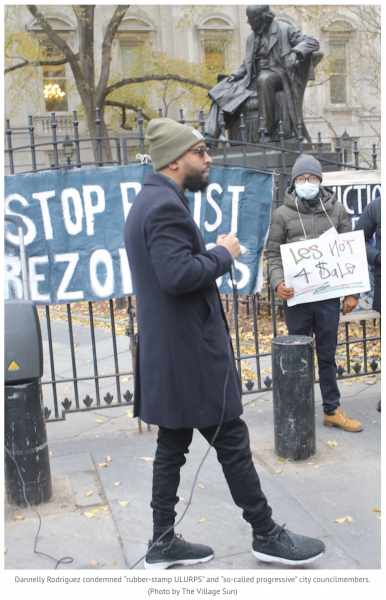
Dannelly Rodriguez, of the Justice for All Coalition and Democratic Socialists of America, decried the Flushing rezoning plan, in particular, and all rezonings, in general. He condemned what he called “rubber-stamping ULURP policies.”
“The rezoning policies in New York State have been racist and classist,” he charged.
“They want to build more housing that we can’t afford, when we’re in the biggest eviction crisis in our city’s history,” he said, incredulously.
Rodriguez noted that the very spot the rally was being held on had been an “autonomous zone” this past summer when it was taken over by Occupy City Hall.
“They evicted us from here, too!” he said, indignantly.
Rodriguez slammed the city’s Mandatory Inclusionary Housing program, under which rezonings allow developers to construct larger market-rate buildings, as long as they include a percentage of affordable units. The city claims this is the only way affordable housing can be built nowadays since these projects incentivize developers with the carrot of profits.
“They love spewing this capitalist neoliberal…that they need access to capital,” Rodriguez scoffed of the M.I.H. scheme. “What they need to do is tax the damn rich!
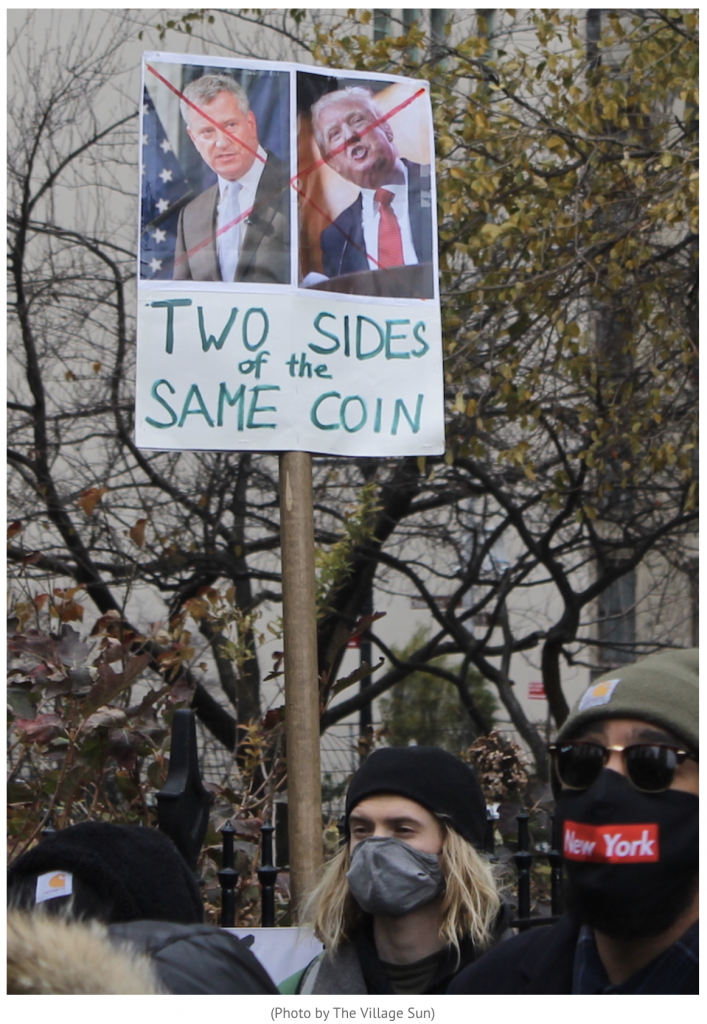
“Abolish this ULURP crap, yo!” he added. “And forget about this ‘input’ crap. If the community says ‘no,’ they mean ‘no’! And [then] go home!”
Rodriguez then ticked off a list of city councilmembers he dubbed “so-called progressives” who, in fact, have supported the rezonings. Number one on his list was the East Village’s Carlina Rivera, followed by Diana Ayala, Farah Louis, Francisco Moya, Justin Brannan, Ben Kallos, Keith Powers, Mark Levine, Antonio Reynoso and Vanessa Gibson.
“You can’t say ‘Black Lives Matter’ but then vote for policies that are against that,” he chided. “It’s over for that.”
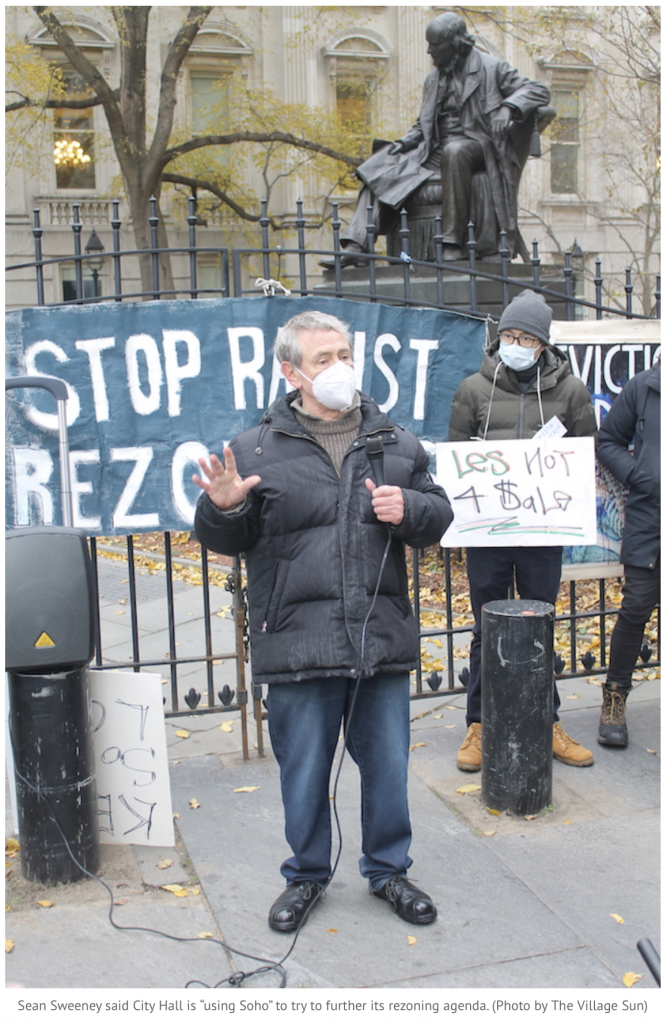
Sean Sweeney, the director of the Soho Alliance, accused the mayor of “using Soho to justify rezonings.” Basically, the de Blasio administration and Open New York, a thinly veiled developer-driven advocacy group, argue that Soho and Noho must have more affordable units and more racial diversity “to do their share.”
“Yes, Soho is 85 percent white,” Sweeney acknowledged, “but there’s a fund, so the affordable housing could be built in other neighborhoods.”
In other words, as Sweeney indicated, the affordable housing that would be linked to an M.I.H. plan for Soho and Noho would not actually have to get built specifically in those areas.
Also, the activist said, never before in New York City since the creation of the Landmarks Preservation Commission in 1965, has City Hall dared to upzone a designated historic district, such as Soho and Noho.
“They want to do away with 50 years of landmarking so Bill de Blasio can satisfy his campaign donors,” Sweeney protested.
Finally, he said, it’s time to pull the plug on the current use of Zoom meetings on such critical land-use issues as rezonings.
“This is a public meeting,” Sweeney declared of the activists gathered on the blustery plaza. “Do away with Zoom meetings — that’s bulls—!”
Sweeney recently led an effort within the Downtown Independent Democrats political club to withhold its endorsement of Carlina Rivera for reelection until she answered whether she supports upzonings in historic districts. (Rivera’s District 3 contains half of Noho.) Nevertheless, D.I.D. subsequently recently did endorse Rivera, who so far is running unopposed, even though she had not yet held a promised follow-up meeting with club members, at which it was hoped she would clarify her position.
Speaking out against another project in a Lower Manhattan historic district was Stacey Shub, of Save Our Seaport. Howard Hughes Corporation is seeking to build two megatowers — larger than would normally be allowed — on a parking lot there, right next to two schools.
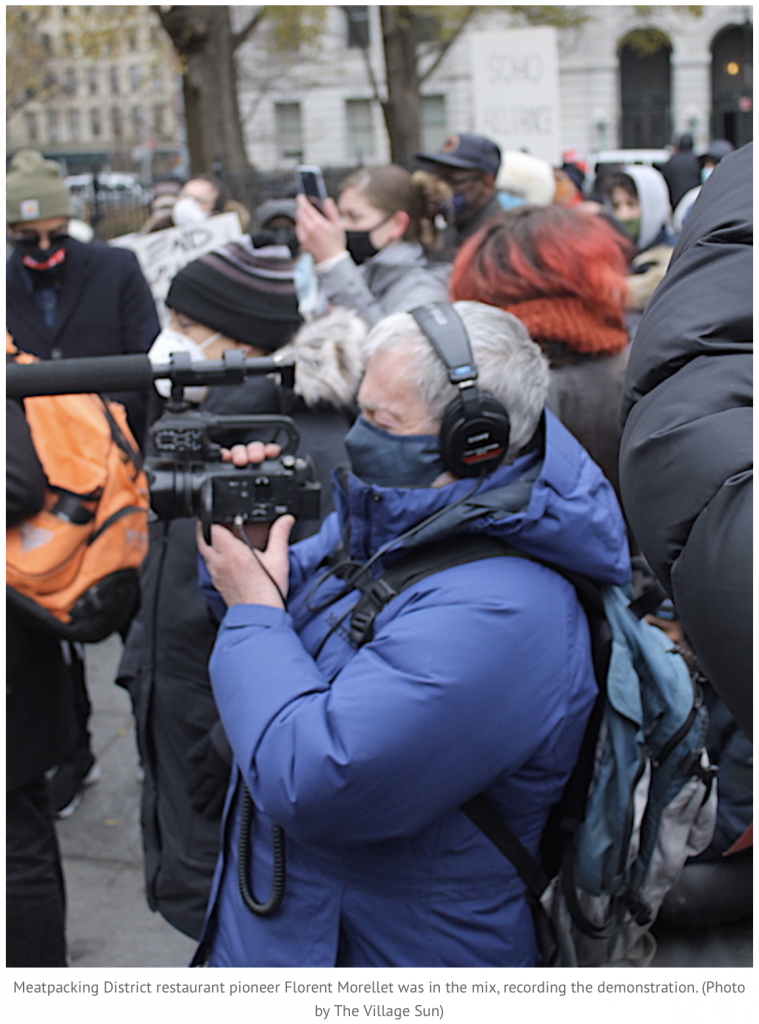 Lina Melendez, of Northern Manhattan Not For Sale, said residents are still fighting the city’s Inwood upzoning plan. The struggle now is continuing in federal court.
Lina Melendez, of Northern Manhattan Not For Sale, said residents are still fighting the city’s Inwood upzoning plan. The struggle now is continuing in federal court.
A common complaint about the M.I.H. projects is that the affordable housing in them is not really very affordable. Melendez said that, when affordable housing rents are determined, instead of basing them on area median income, the more accurate community media income should be used.
Like other speakers she also slammed the ULURP review process, charging that the premise of public input is a charade.
“Once that ULURP is announced,” she said, “that deal is cut. … The money is slipped under the table.”
Lorem ipsum dolor sit amet, consectetur adipiscing elit. Ut elit tellus, luctus nec ullamcorper mattis, pulvinar dapibus leo.
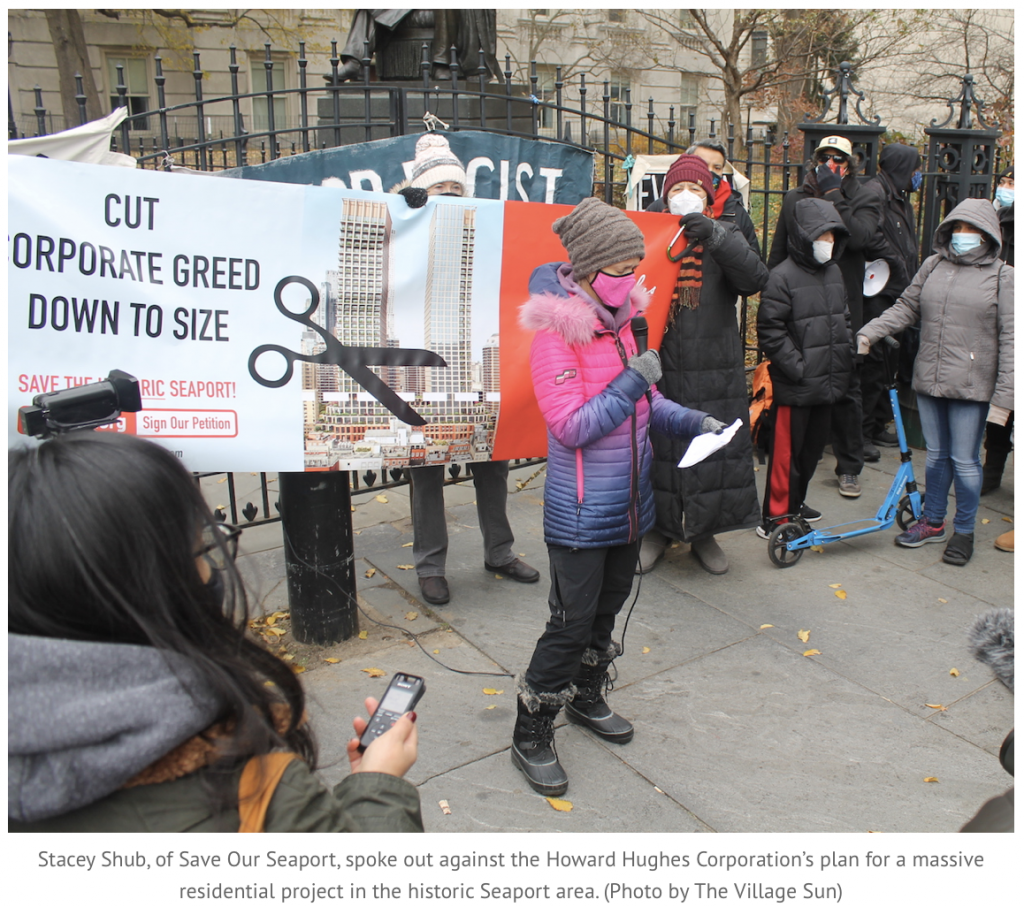
Other speakers condemned plans that would overshadow the Brooklyn Botanic Garden with new residential towers or develop a major site in Sunset Park as a Plan B after the defeat of the Industry City rezoning.
The list went on and on.
Chris Marte, a candidate for City Council in Lower Manhattan’s District 1, stood in the crowd listening to the speakers from the community groups. He shared some of his thoughts on the hot-button topic with The Village Sun.
For his part, Marte said he supports the Alternative Community Rezoning plan for Soho and Noho, which has no upzoning, plus more and deeper affordability than the city’s plan.
The City Council candidate also noted that yet another new rezoning — for Governors Island — is coming down the pike for District 1. The plan could include up to 30-story buildings.
“They’re using the excuse of having a science center,” he said, “but it could lead to building hotels there and commercial retail spaces.”
Roger Manning, a co-leader of Metro Area Governors Island Coalition, or MAGIC, said the new group formed only about a month ago.
“It’s a refuge for New Yorkers,” he said of the island. “It’s a park. It’s accessible to all New Yorkers. It’s public land — they’re trying to sell it off.”
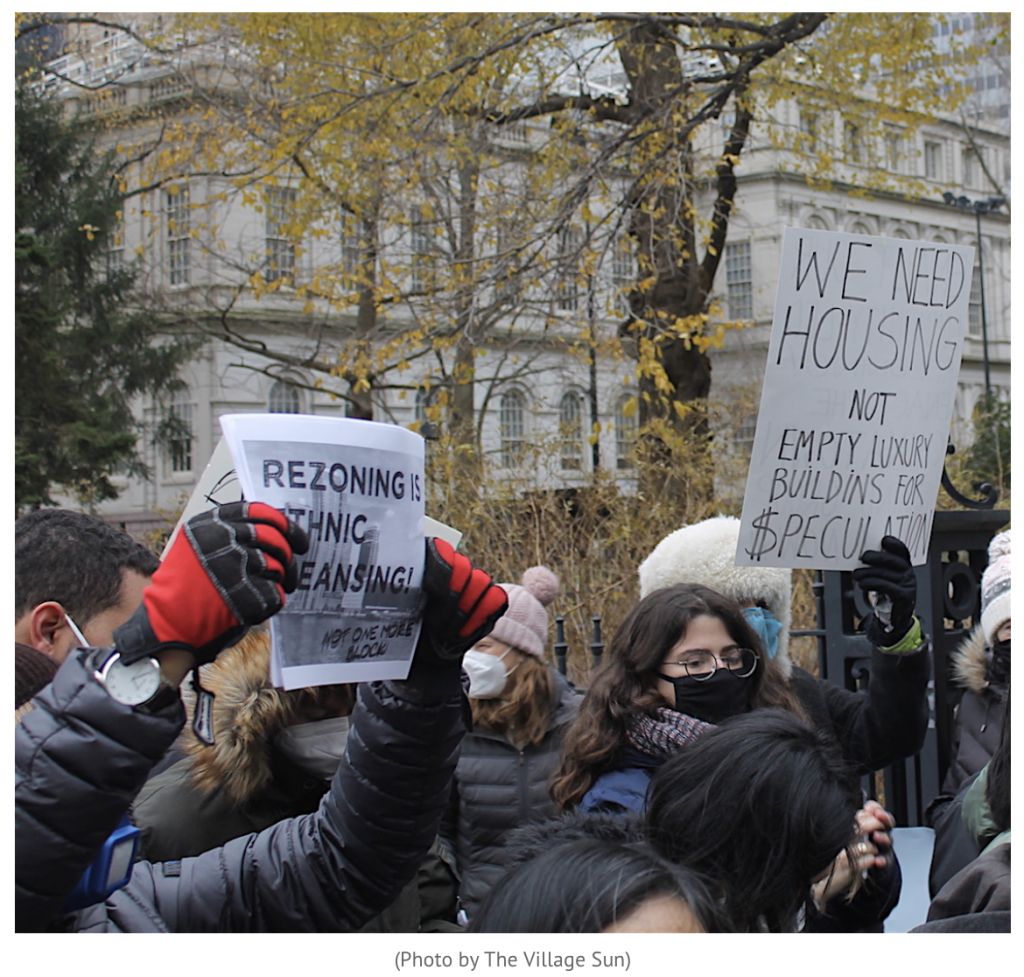
“It’s crazy. I think they’re trying to get everything in before the end of the administration,” he said of the city’s push on rezonings.
“Why during a pandemic are we forcing all these rezonings?” he asked. “It’s because they have no certainty about the next City Council and the next mayor, so they’re trying to get everything through. It’s disappointing.”
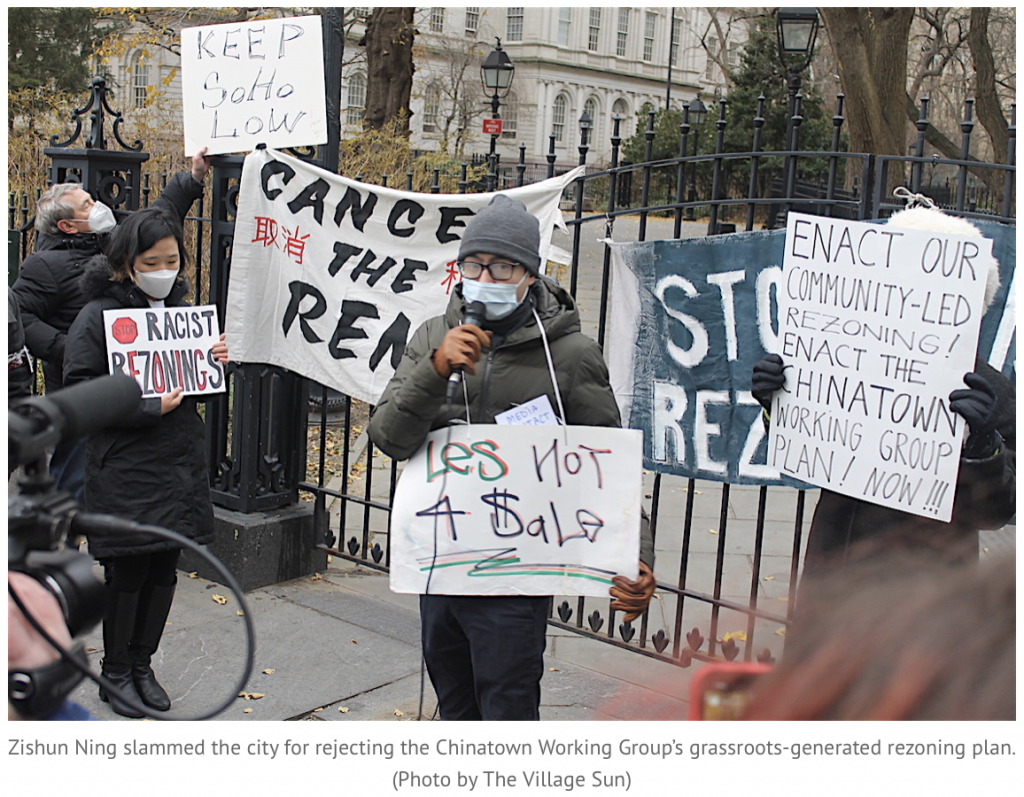
Meanwhile, Zishun Ning, a member of Lower East Side Organized Neighbors (LESON), said the one time the community actually presented a real grassroots rezoning plan, by the Chinatown Working Group, the city snubbed it.
“We are so sick and tired of the displacement agenda and of the racist agenda,” he said. “And we are so sick and tired of Mayor de Blasio and this City Council.”
Ning then called out, one by one, the names of neighborhoods around the city facing zoning projects — from Soho and Noho to East Harlem, Jackson Heights and the South Bronx — with the crowd shouting after each one, “Not for sale!”
Ning concluded the list, his voice rising to a crescendo, “New York City — Not for sale! New York City — Not for sale!” as the activists shouted along and cheered in agreement.
Lindsey Boylan, a Chelsea resident who is running for Manhattan borough president in the Democratic primary, also attended the rally. She posted a statement on Instagram about her views on the issue.

We need to create a New York City where new housing growth is spread across all neighborhoods rather than just in low-income communities of color, and projects that are pushed not for developers but led with input from the community. #nyc
In addition to rezonings, another de Blasio mega-plan was on the mind of at least one person in the crowd. Standing with a protest sign in her bicycle’s front basket, Barbara Katz Rothman said she was with East River Park ACTION. The group is fighting the city’s East Side Coastal Resiliency plan, which would bury East River Park under 8 to 9 feet of infill dirt to turn it into a massive flood barrier.
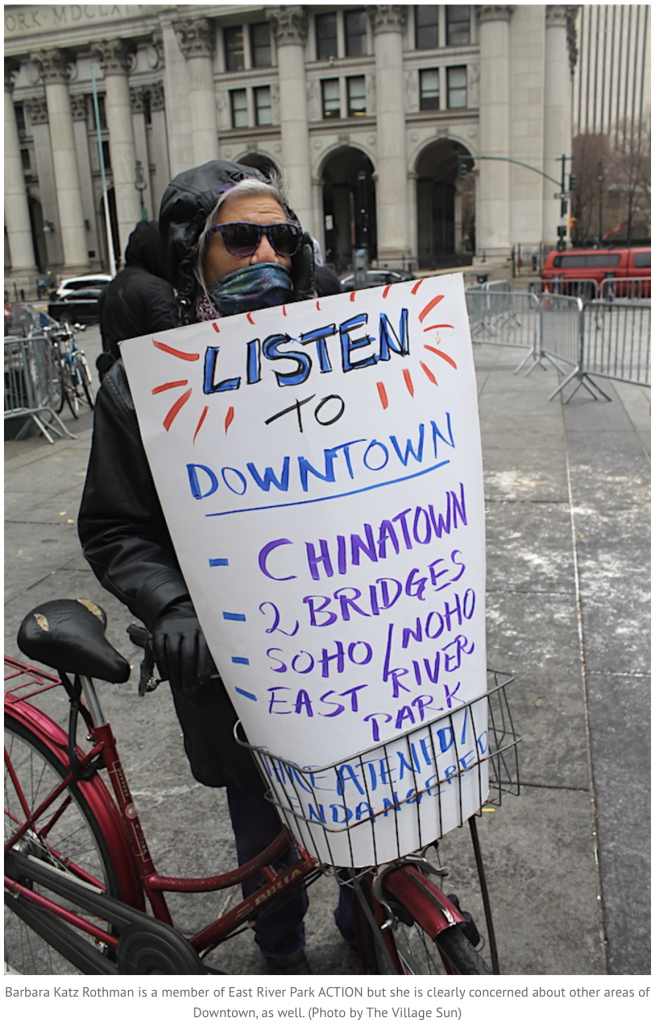
Katz Rothman said her main concern was the impact the project would have on local asthma rates. Residents living in public housing near the park already have high rates of asthma and lead poisoning, she noted.
“A decade of tearing down and rebuilding that park,” she said, “lots of particulate matter will be in the air.”
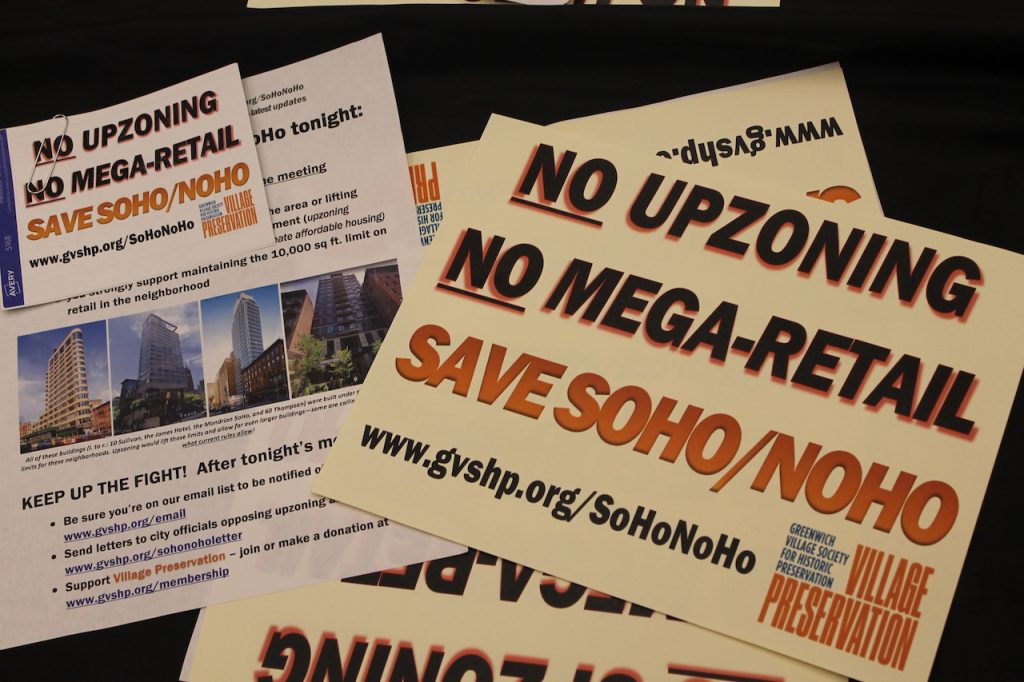
Dozens of organizations from across four boroughs — including an array of community, civic, cultural, environmental and preservationist groups — are joining together to demand an end to Mayor de Blasio’s upzonings.
The groups — which will rally by City Hall at Chambers and Centre Sts. on Wed., Dec. 16, at noon — charge that de Blasio’s upzonings are, in fact, largely a “giveaway to his developer friends and campaign donors.”
The event, billed as a “Save Our Soho/Save Our City” rally, will be protesting not only the mayor’s plans for Soho and Noho, but also his upzoning schemes throughout the city. Soho Alliance members will be featured speakers.
The groups are also demanding an immediate “pause” to Zoom land-use-review public meeting
The activists charge that, in the current COVID climate, the Zoom meetings on land-use issues, like upzonings, are “tightly controlled by the Department of City Planning, do not meet the legal requirements for an actual public meeting, and inhibit true grassroots participatory democracy.”
“Moreover, the Zoom ‘public’ meetings are fraught with technical problems,” a press release for the protest said. “Remote meetings are not how ‘public’ meetings work. Public meetings are held in public, not in the cloud.”
In October, The Village Sun reported how city planners “muted” community protest over the Soho/Noho rezoning plan at a recent meeting by carefully curating which members of the public could speak.
Wednesday’s rally will use COVID precautions and masks are required.
Participants will include:
9th Street A-1 Block Association
The shift to remote-only civic meetings during the pandemic is impacting how communities get to weigh in on important city proposals, like rezonings. It’s led to more people attending — but there have also been problems, and criticism.
by Sadef Ali Kully

The day before a virtual public meeting about the city’s proposed SoHo/NoHo rezoning, Sean Sweeney, the head of the Soho Alliance, got an email saying he needed to update his Zoom software. So he did. Sweeney was going to be one of the first panelists to share feedback at the meeting on the draft scope, a document detailing the city’s proposed land-use actions and outlining the methods it will use to study the project’s potential impacts.
But on the day of the Dec. 3 meeting, Sweeney was told by city officials that his Zoom software still needed to be updated. Confused, he logged out and made another unsuccessful attempt to join. After an hour passed and over a dozen people had already testified, he gave up, deciding to try and join the public hearing by phone instead—and by luck, was called on and given the chance to testify almost immediately.
“They said, ‘Oh, let’s pick someone from the phone.’ So I guess I was the first one to phone in and they arbitrarily picked someone who just phoned in. They didn’t know my name. They just knew the last three digits of my number,” he says. The good timing meant he got to speak at the virtual meeting before others who’d been waiting online to do so—one example of the many ways that the shift to remote-only civic meetings during the pandemic is impacting how communities get to weigh in on important city proposals.
“Someone who might’ve been waiting an hour on the computer, had they gone to the phone would have gone on instantly,” said Sweeney in an interview with City Limits. “So there is an inequity. If you’re sitting waiting to speak at an in-person public meeting and someone happens to come in the side door and they get pushed right up—that would never happen in a public meeting in a room.”
When the pandemic struck the city in March, Mayor Bill de Blasio issued an emergency order to halt the Uniform Land Use Review Procedure (ULURP), the city’s months-long review process for land use proposals like rezonings. The city restarted that process in October, but shifted to virtual public meetings, launching an online portal, NYC Engage, where people can find information and register to join meetings either virtually or by phone. Residents can also place requests in advance for language interpreters and other services.
There are two public rezoning proposals underway—Gowanus in Brooklyn and SoHo and NoHo in Manhattan—which are expected to be certified, and start the ULURP process, in January. Public meetings relating to both projects have been held remotely in recent months to plan for that, and city officials say the online format has provided a boost to attendance numbers, with hundreds tuning in.
According to Department of City Planning data, the SoHo/NoHo scoping meeting on Dec. 3 saw over 150 attendees, while an information session about the proposal in October drew an estimated crowd of 500. More than 350 people logged into a meeting on the Gowanus rezoning proposal on Oct. 22, another 250 attended a November presentation about the city’s plans for Gowanus Green, and another meeting about the Brooklyn neighborhood’s infrastructure this month had an estimated 200 people watching. The City Planning Commission (CPC) hearing on the Special Flushing Waterfront District on Nov. 4 saw more than 230 people register to testify.
Attendance outnumbered those of in-person public meetings held last year related to these and other rezoning proposals, officials say: two workshops about plans for SoHo/NoHo, hosted in February and May 2019, had 150 and 200 attendees respectively, while meetings related to the Gowanus proposal also averaged between 150 to 200 attendees last year. In February, right before the pandemic struck, a CPC hearing on the now-dead Industry City rezoning proposal had just 57 people registered to testify.
According to DCP, the virtual platform for public meetings has been successful in engaging more people than in-person meetings would otherwise, and the agency says it is looking to make more improvements to the format in the near future.
But some residents and stakeholders have taken issue with the use of virtual-only meetings, saying it’s inaccessible for those who lack access to internet services. Others feel it can create issues around fairness when it comes to who gets to speak, and when, such as in Sweeney’s example. Residents also say that not being able to see their fellow community members and know who is tuning into such meetings makes organizing—either in support of a project or policy or against it—more difficult.
NYCHA resident and community activist Karen Blondel, who works with the Gowanus Neighborhood Justice Coalition (GNJC), raised that last issue at a recent Gowanus rezoning-related meeting, where she said she had no idea if other NYCHA residents were tuned into the city’s presentation on its proposal, which could impact Gowanus’s public housing residents significantly.
“I felt alone as a community. I could not see GNJC members or NYCHA residents. We spent a lot of time in person understanding the community’s approvals and disapprovals in past meetings. That was missing,” Blondel said. “We should not do ULURP until we can meet in person.”
She added that if the city continues with virtual meetings, then it should publish a participant list for each event so attendees can know who else is present. “To make sure that the people there are not trolls, coming from other spaces and have 15 to 20 of their members speak. And then nobody from the community gets to speak,” she says. “Even on Zoom, there’s no way to determine the order of who raised their hand first or asked to speak. So it can be biased based on the host.”
Blondel thinks the city should continue doing outreach online but wait until the spring to hold actual public meetings, when communities can meet in-person outdoors in better weather conditions. A Manhattan community group, Village Preservation, offers a similar idea: to pause the ULURP process until there is an opportunity to have in-person (with social distancing) and virtual public meetings, simultaneously.
“Without a doubt, I think that there are certain advantages to having the virtual format and my hope would be that in the future one would be able to participate both virtually and in person. But there’s also no denying that there’s a loss, a significant loss from the lack of in-person participation, particularly in terms of the way that the city structures these, which is that you can’t see anybody who the city doesn’t allow you to see. You’re basically in a black box,” said Andrew Berman, the group’s executive director.
Virtual meetings also make it harder to get a general sense of a community’s support or opposition to a proposal which are easy to convey in person, such as attendees holding signs or wearing buttons, he added.
“There’s no way for people who are in attendance to disseminate information among one another. So it really is extremely limiting,” he says. Such participation is vital for high-stakes land use projects. “The fact of the matter is with something like a vast proposed rezoning for two communities, there’s no reason why it can’t wait until we’re able to return to an in-person format, which hopefully would also allow for virtual participation.”
With a vaccine potentially around the corner, it makes sense for the city to hit pause on ULURP until it’s safe again to convene in person, these critics argue.
“I think that there’s a real feeling right now that certain political powers are taking advantage of the pandemic to streamline public review processes. And I think at the root of it, I think there’s real concern that these technical platforms are not designed to be a democratic forum and they are not designed to in such a way that they are accessible to all. And there is this assumption that this process is somehow equivalent or good enough because of the pandemic,” says Jack Riccobono, a member of the community group Voice of Gowanus.
“When you’re talking about a discretionary action like ULURP and the rezoning process, which has a time horizon of 10 to 20 years and are often under consideration for years before action is taken–it’s really hard to make the argument that this has to happen right now,” he adds.
DCP counters that the virtual meetings have been critical for those who would otherwise be unable to join in-person public meetings due to work schedules, family commitments or accessibility difficulties. The agency says it also works with attendees to help them participate both before and during remote meetings.
There have indeed been moments during recent online meetings that shed light on the flexibility of a virtual platform: A union member who had his daughter help him make his video testimony in support of the Gowanus rezoning in the middle of running an errand, or the Soho senior who moved upstate during the pandemic for her own safety who was still able to share feedback on the SoHo and NoHo proposals.
“Neighborhood planning is more important than ever as we think about recovery. This is a moment in time where we need to make a centralized place to find information on meetings,” says Lara Merida, DCP Director of Neighborhood Studies. The city’s Engage NYC portal does just that, she says, letting residents view upcoming meetings, watch past events and access documents related to each project.
Merida said the platform has also helped the agency itself, allowing flexibility for DCP employees to attend more meetings in different parts of the city. She said the website was in the works even before the pandemic, but the health crisis jump started its launch.
Like all technology, there are limitations, Merida admits. But the city is continuously working to improve: The public can expect to see video conferencing tools soon which will allow meeting attendees to see each other, she says, though did not give an exact timeline for when that will happen.
“We’re constantly speaking to members of the public and sister agencies, advocacy groups, and educational institutions to try to improve all of the civic engagement that we’re doing online,” she says.
BY THE VILLAGE SUN | A Community Board 2 committee sought feedback on the city’s Soho/Noho upzoning plan at a public hearing last Tuesday. But locals instead stressed they don’t want any upzoning at all, with some saying they strongly preferred a community alternative rezoning plan without any upzoning.
Some residents further said what’s really needed is a “building by building” assessment of the two Downtown enclaves. They charged that advocates of the city’s plan are unfairly painting the area with a broad brush to make everyone living there seem rich, when it’s simply not true.
More than 155 people attended the virtual public hearing held by the C.B. 2 Land Use Committee. The hearing concerned the environmental scope review for the city’s rezoning plan, though not the proposed rezoning itself. If the plan moves ahead, there will be more public hearings on it next year.
The city plan calls for Mandatory Inclusionary Housing, which would require a percentage of all new units to be affordable. But the scheme’s critics say the benefits of this new affordable housing would be offset by the far greater amount of luxury housing the plan would flood the area with.
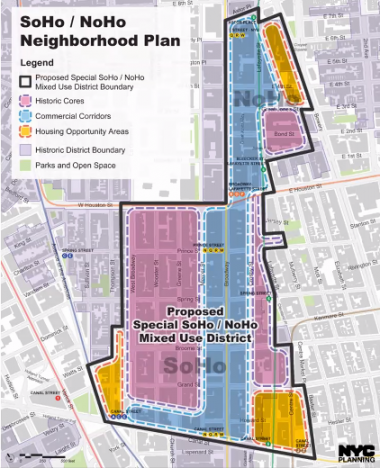
A map showing the city’s plan to rezone — and upzone — Soho and Noho. (Courtesy NYC Dept. of City Planning)
David Lawrence, a photographer and longtime Soho denizen, said the residents in his Grand St. building are all artists, and that 30 to 40 percent of them are black or Asian. About half of the building’s units rent for under $2,000 a month, which qualifies as affordable housing, he added.
“I really resent people saying Soho is rich and white,” he said.
Lawrence lives in a corner of Soho where the city’s plan calls for upzoning to allow 10-to-12-story buildings. If a massive building were constructed there, he said, it would block his light, affecting his very livelihood.
“I would probably have to move,” he stated. “I could not work here.”
Not only that, but an upzoning would only worsen existing traffic problems, he warned.
“Congestion in Soho is untenable,” he said. “I see very little in this plan about traffic.”
Similarly, Micki McGee, of South Village Neighbors, said that 30 percent of the apartments in her area of western Soho are rent-stabilized.
“Many, many rent-stabilized tenants would be threatened with displacement,” by the city’s plan, she said. “Many elderly residents, too.”
However, Douglas Hanau, who supports the city’s rezoning, noted that rent-regulated apartments, even if they are renting for $2,000 or under, “are not income restricted. The new affordable housing would be.”
The Alternative Community Rezoning plan, meanwhile, proposes to create more affordable housing than the city’s plan, plus with deeper affordability, though without any upzoning.
Paul Tschinkel said he moved into Soho when it was “dilapidated,” which was perfect for artists.
“I see developers wanting to come in and piggyback on the artists’ back,” he said. “They should go to Williamsburg and Bushwick. I think it’s outrageous to upzone this and make it a neighborhood no one wants to go to.”
Similarly, Joan Melnick, a 50-year Soho resident, said, “We have watched the neighborhood change from junkies in the hallways to a rather upscale neighborhood over the last 10 years.”
She said that most neighbors in her building favor adding more affordable housing to the area, but there’s “a fear affordable housing will become something else.”
Lora Tenenbaum cited her block as an example of how only a few wealthy residents can drastically skew statistics. While many of its units are rent-regulated, with a mix of Asian and white residents, two apartments were bought by super-wealthy individuals, thus ranking the block among the wealthiest in the city, she said.
“The fact is one of those high-end apartments is occupied by a person of color,” she noted, adding, “This is why we need to do a building-by-building survey [of income levels].”
But John Sanchez, the district manager of the Bronx’s Community Board 6 and a candidate for City Council, spoke in support of the city’s plan. He said many of the Downtown area’s hospital workers and supermarket workers commute from places like his district and should have the ability to live closer to work.
“Essential workers should be able to live anywhere,” he said.
Brandon Zwagerman, director of planning and community engagement for the Broadway Soho Initiative — Soho’s business improvement district — spoke in favor of the upzoning plan. The affordable housing it would bring, he said, would make for a “more equitable recovery from COVID.”
Several speakers noted that Soho does not even have any schools, yet the city’s plan would boost the area’s population. Rosalie Hronsky, who said she moved there 30 years ago because it was affordable for artists, said it has never really been a neighborhood for kids.
Elisa Monté said, “The initial history of Soho and Noho, believe it or not, was affordable housing. To give it to developers to create affordable housing is delusional. They’re developers. They’re there to make a profit. They would do whatever they can to get out of creating affordable housing.”
She blasted the city’s rezoning plan as “naive and delusionary.”
Similarly, Victoria Hellstrom said advocates’ relentless spin of the city’s plan as mainly to create affordable housing is misleading.
“I feel that I’ve been at a Trump rally and need to take a shower,” she said, in exasperation. “The fact is this is a market-driven plan.”
“I think this is just another developers’ dream,” echoed Anita Isola. “This will devastate a historic area and will displace many people who are living in affordable housing now.”
Another longtime resident complained that the development plan is being rushed — “blowtorched and bulldozed,” as she put it — to ram it through to approval. But Mayor de Blasio, who is facing term limits, has said he thinks there’s plenty of time to get the rezoning plan through the city’s ULURP review process next year, his final year in office.
By Elisabeth Rosner
December 8, 2020
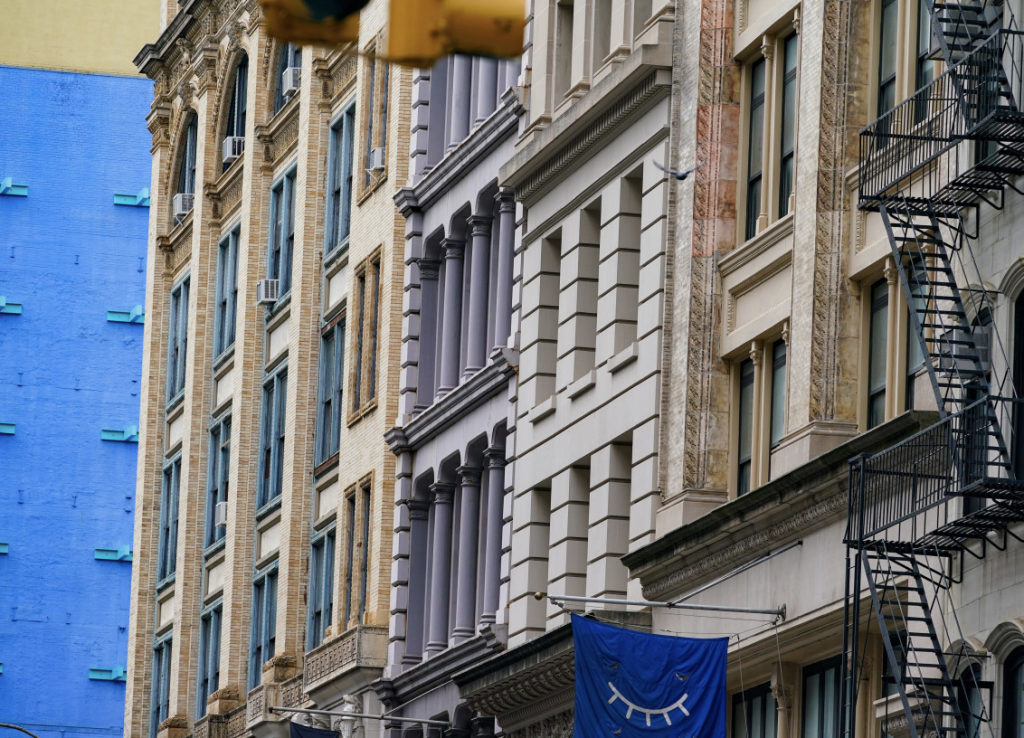
John Nacion/SOPA Images/Shutters
Downtown residents disputed the city-led rezoning plan for Soho and Noho during Manhattan Community Board 2’s Land Use Committee virtual public hearing on Tuesday evening.
Locals criticized Mayor Bill de Blasio’s proposal as “delusional” — which calls for 3,200 new apartments, including 800 affordable units to the upscale area, plus an update of 50-year-old regulations for business owners and artists.
“I do not understand to this day why the city, with an outgoing mayor has not taken advantage of developing affordable housing and city owned property,” said one speaker.
One woman said the mayor wants to destroy the “historical district in the middle of a dystopian pandemic,” to make a deal with developers — and make their families “super rich.”
Lower Manhattan community organizations on the call touted a plan in contrast to the city’s, which they say would “allow new development up to 2.4 times the size current rules allow and a deluge of oversized luxury condos.”
Many of the speakers at the hearing were artists who have lived in Soho for decades and said the city made no contributions to make downtown affordable when they moved.
They didn’t want to see the fabric of the neighborhood change.
A 50-year resident of Soho thinks new development should happen in Bushwick or Williamsburg, and he was concerned about the lack of parking.
“What’s going on here is pretty simple,” said Soho resident Jacob Schmidt.
‘”A group of housing millionaires who are mostly old and white are blocking access to an extraordinary valuable neighborhood [to anyone] who didn’t buy an apartment here in the seventies.”
The last speaker on the call was for de Blasio’s rezoning plan, “I’m sorry I’m just going to be one of those people who accepts the premise that supply and demand matters.
“We need to increase housing supply in this city if we want to achieve better levels of affordability.”
“And what better place in New York City to add some of that housing supply than SoHo. It’s a place that is rich in residential housing, it’s rich in jobs, and it’s rich in transit,” he concluded.
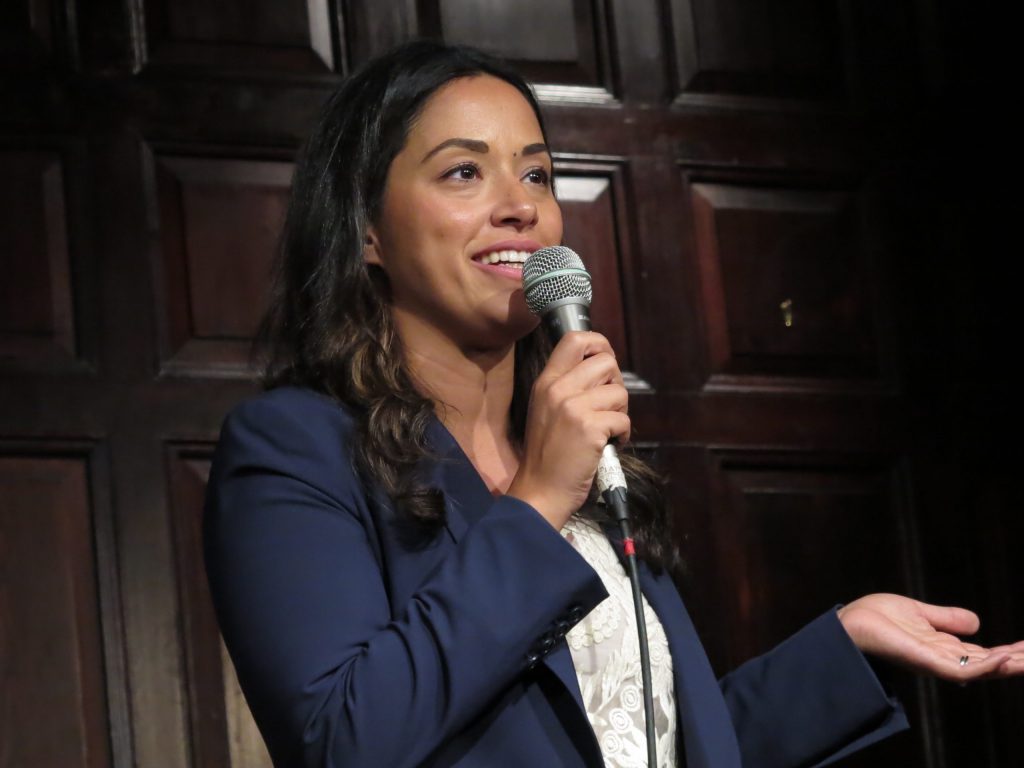
Where does she stand on upzonings for historic districts? Councilmember Carlina Rivera speaking at Theater for the New City’s benefit gala in March. (Photo by Jonathan Slaff)
BY THE VILLAGE SUN | Hold your (historic district) horses!
The Downtown Independent Democrats political club had planned to make endorsements last Monday evening after hearing from candidates for the Second and Third City Council districts.
But, after a vigorous debate among its members, D.I.D. decided to delay endorsing in both races until it heard more from Councilmember Carlina Rivera on whether or not she supports upzonings in historic districts, which are landmarked areas.
A follow-up meeting has been set up between Rivera and club leaders, at which she will be asked to clarify her views on the subject.
In short, some D.I.D. members felt Rivera had been evasive during the candidates forum when District Leader Jeannine Kiely asked for her position on that issue, as well as on the city’s planned upzoning in Soho and Noho.
Soho and Noho are historic districts.
Rivera, who is running unopposed in the primary election, represents District 2, which includes the East Village.
“I think that one thing we can all agree on is that the 1970s zoning is outdated,” Rivera responded to Kiely, referring to Soho and Noho’s unique zoning. “I think if you are going to do this the right way, an upzoning [there] is appropriate. I think that the way the mayor approached this is the wrong way.”
Rivera said she had been “deferring” on the Soho/Noho rezoning to Councilmember Margaret Chin — whose district contains both neighborhoods — and Manhattan Borough President Gale Brewer. Chin and Brewer, along with the Department of City Planning, led the push to do an “envisioning” study for the rezoning.
While Rivera, in her answer, mentioned having supported the Essex Crossing development on the Lower East Side, which includes extensive affordable housing, she did not directly answer Kiely’s more general question on upzoning in historic districts.
For a significant number of D.I.D. members, that was a problem.
Richard Corman, the club’s president, confirmed that the endorsement votes had been delayed, but he did not want to comment on the record on the reasons why.
Sean Sweeney, the D.I.D. vice president, was a vocal leader of the club faction that successfully pushed to delay the vote. Afterward, he spoke to The Village Sun about it, though stressed that he was talking not as club representative but as the director of the Soho Alliance.
“There are several historic districts in her district,” he noted of Rivera. “Does she support upzoning in her district? Does she support the upzoning of other historic districts — in Greenwich Village, in the Meatpacking District, in Chelsea, in Brooklyn Heights? Even in Queens, Douglaston?
“Does she support — over all, citywide — upzoning in historic districts?”
It’s an important question, Sweeney said, because with more than 30 councilmembers due to be term-limited at the end of next year, Rivera is a leading candidate to be elected Council speaker.

A map showing the city’s latest iteration of a proposed “Special Soho/Noho Mixed Use District.” Blocks marked yellow are designated as “housing opportunity areas” where dense and tall development could occur. Commercial corridors, including Broadway and Lafayette and Canal Sts. — but also Crosby and Mercer Sts. — would also be upzoned under the proposal.
“Maybe if she wants to sacrifice Soho, O.K., that’s her decision,” Sweeney offered. “But as the speaker, it’s important to find out whether she supports upzoning in historic districts — in her bailiwick, in other candidates’ districts. She could be speaker and she should [state her position].
“She’s parroting the Open New York line,” Sweeney accused, “and she’s parroting de Blasio’s failed Mandatory Inclusionary Housing.”
Open New York is a group of primarily young white men who issued a report backing a Soho/Noho upzoning and who have regularly shown up at outreach meetings to testify in favor of the initiative.
“It’s a phony astroturf group funded by the heir to a real estate fortune,” Sweeney scoffed.
Meanwhile, he countered, there are many more members of preservation groups in New York City — like the Historic Districts Council and the Landmarks Conservancy — than there are Open New York members.
“I bet there are over half a million people living in historic districts,” he added.
Also, Sweeney continued, the idea that M.I.H. would create affordable housing in Soho and Noho — which Open New York and the de Blasio administration trumpet — is, in itself, a fallacy since the developers could just use a “credit” and build it in another neighborhood.
“That’s the whole joke,” he said. “That’s the three-card monte flimflam scam.”
The longtime Soho activist evoked the name of a former City Council speaker, Christine Quinn, warning that he didn’t want to see Rivera — if she becomes speaker — follow in her footsteps on development matters.
“We had a speaker who similarly started out as a community and a housing advocate,” he recalled of Quinn. “Yet once she became speaker, she did a 180-degree turn and became very supportive of real estate developers. I would hate to see that happen with another speaker.”
Sweeney said if D.I.D. is to have any leverage with Rivera, it’s now.
“We realize she does not need our endorsement,” he said. “But we do not expect a candidate running for office to ignore a simple question. She’s gonna win [reelection], she doesn’t need us. But if we have any leverage, it is now. It’ll be zero leverage if she’s elected to a second term. I want historic districts throughout the city to know what her position is on upzoning historic districts.
“We like Carlina,” he continued. “But she just can’t avoid a legitimate question about a citywide concern — that affects not just historic districts in her district but throughout the city — at an endorsement meeting.
“That’s all we want. We felt if we let her off now, we would never ever have the chance [to grill her on the issue].”
Sweeney added there was, however, a telling “generational split” within D.I.D. on whether to endorse after the candidates forum; the younger members were more apt to let Rivera off the hook, despite her dodge, while the veteran community activists demanded to put her on the spot and make her answer.
“The community activist faction were the ones who wanted to postpone [the endorsement],” Sweeney said, “meet with Carlina and go over the report on the rezoning that just came out. It’s a 60-page report, fine print. We don’t even know if she’s read it yet.”
Rivera did not respond to a request for comment, asking her to clarify her position on upzonings in historic districts.
Broadcast Date
November 4, 2020
by WBAI Radio’s Living for the City, J. Jonas
I don’t think any New Yorker would be surprised at this point–well into Mayor de Blasio’s second and final term–that the administration is trying to push as many developments and rezonings as it can cram in, before he leaves office next year—pandemic be damned. Despite saying publicly earlier this year there wouldn’t be sufficient time procedurally for a complex upzoning in SoHo and NoHo–and despite months of silence on the subject–the mayor changed course completely in October and announced that in fact they would be trying to get this through. And according to opponents, it is so much worse than anticipated. With me to discuss this are longtime friend Andrew Berman, the executive director of Village Preservation at the Greenwich Village Society for Historical Preservation and Sean Sweeney, longtime director of the SOHO Alliance.
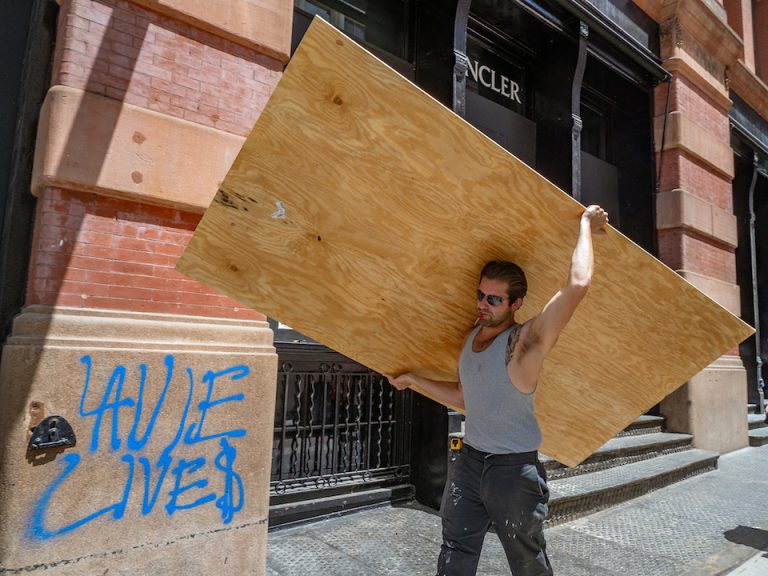
Boarding up a storefront in Soho in early June after the neighborhood had been rocked by a wave of looting. Some merchants are now boarding up again, fearing election-related looting and vandalism. (Photo by Milo Hess)
November 2, 2020
BY THE VILLAGE SUN | Updated Mon., Nov. 2, 9:45 p.m.: Make Soho Safe Again? … MSSA? …
According to alleged “Internet chatter,” amid concerns of vandalism and looting around the election, Trump supporters were mobilizing to try to protect Soho on Monday.
The idea, apparently, was to avoid what happened at the end of May and early June when looters rampaged in Soho, ransacking its pricey boutiques.
Sean Sweeney, director of the Soho Alliance, e-mailed The Village Sun that he got a phone call Monday from a detective he knows at the First Precinct who gave him the heads up. However, the Soho leader admitted he remained skeptical.
“He said they have received some Internet chatter that a guy is organizing some ‘500 residents of Lower Manhattan who support Trump’ and who will be patrolling Soho and other spots with baseball bats and other weapons to deter Antifa and BLM looting,” Sweeney said.
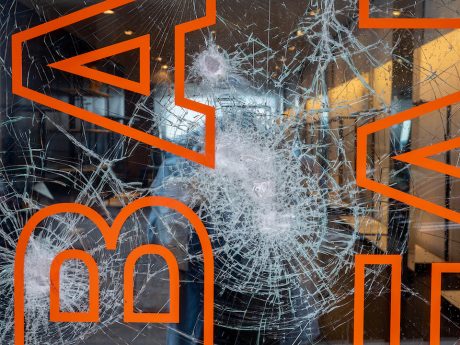
A smashed window in a boutique in Soho in early June. (Photo by Milo Hess)
“I told him there aren’t 500 Trump supporters in all of Downtown!! lol.
“Anyway, he said these vigilantes plan to ‘patrol’ the street in front of the Apple Store [at Prince and Greene Sts.] today at 5 p.m., but that the NYPD will discourage them from assembling. I told him I think the guy organizing it is a nut and doubt it would materialize.
“He also said the NYPD will have a heavy police presence and has plans to cordon off Soho if looting starts.”
Asked his thoughts on the rumor of Trumpites defending the district’s shops, Sweeney said, “I welcome police help. Vigilantes are not welcomed in Soho. … But I bet it is just some loser typing away his fantasies on a computer in his mother’s basement.”
Meanwhile, regardless of whether the alleged bat-wielding Trump backers were fact or fiction, there’s no doubt that merchants in Soho — as in other parts of Manhattan that were hit earlier this year — are taking matters into their own hands by boarding up their store windows.
Soho activist Bill Dobbs saw boutique windows already covered up on Monday.
“This morning I noticed new plywood on the windows of at least two stores in Soho,” he said, “Sunglass Hut, at West Broadway and Spring St., and Gucci, on West Broadway near Broome St. Gucci was vandalized extensively in June; they’ve already painted the plywood but I’m quite sure it’s recent. Probably more [stores are boarded up] on other streets.”
Indeed, The New York Post reported that many stores are putting up protection, including other Soho outlets, like Chanel, Dior, Moncler, Levi’s and Tiffany, plus Bed, Bath & Beyond near Union Square and Macy’s in Herald Square.
On Saturday, plywood could already be seen covering all the ground-floor windows at Macy’s but the doors were still open for customers.
At any rate, 5 p.m. on Monday rolled around and Sweeney strolled by the Apple Store to find…not much going on.
“There were three cop cars at the Apple Store but business and pedestrians were going on as usual,” he said. “No vigilantes.”
Sweeney, who is good at sleuthing out people through Internet searches, subsequently did one on the guy who posted on Facebook about organizing the Soho patrol and it turns out he’s not even local.
“He lives in North Carolina,” Sweeney said. “It is just some nutcase blowing his horn. … But I guess the cops had to take it seriously.”
However, the fear of election-related mayhem remains real in Soho — partly because it is being pushed hard by the major media.
The activist said he heard of one resident who recently finished a lavish apartment gut renovation who has hired guards to live in his place while he heads to his country house to ride things out.
“I have been fielding so many e-mails today,” Sweeney said.

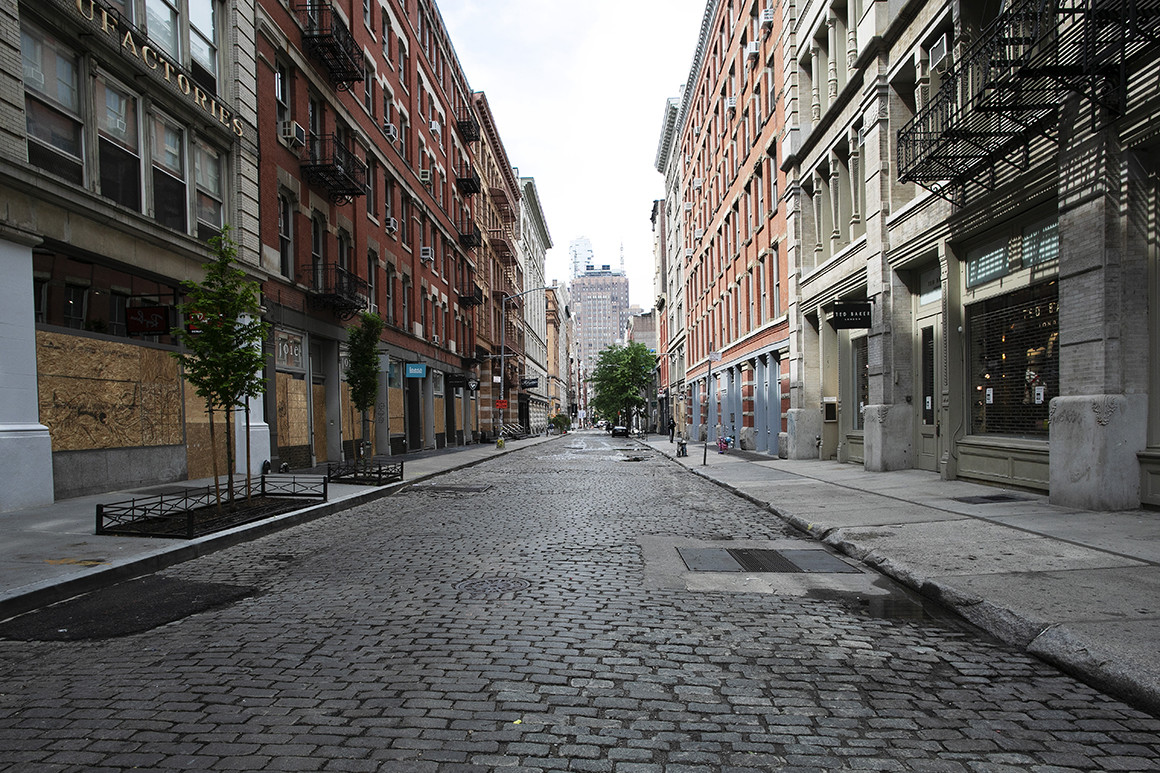
A deserted street is seen in Manhattan’s SoHo neighborhood. | Mark Lennihan/AP Photo


The latest map of the proposed Soho/Noho rezoning shows in yellow the areas where the city would seek to “maximize” development. The yellow zone at the lower left has been shaved down a bit since an earlier version of the map, leading locals to surmise that Councilmember Corey Johnson has cooled on the initiative. (Dept. of City Planning)
Planners pitch Soho/Noho rezoning but mute (literally) community concerns
October 28, 2020
BY THE VILLAGE SUN | There weren’t a lot of fireworks at Monday’s meeting about the city’s suddenly revived push to rezone and upzone Soho and Noho. That probably wasn’t surprising, though, given that the meeting was virtual, with audience participation tightly controlled by the Department of City Planning.
State Senator Brad Hoylman did shake things up, though, when he compared the city’s last-minute rezoning rush to the confirmation of the U.S. Supreme Court’s newest justice just one week before the presidential election.
“This is the Amy Coney Barrett of rezoning projects,” Hoylman scoffed. “You have 15 months left and under the climate of COVID… .”
He was referring to how much time Mayor de Blasio has left in office before he is term-limited out of City Hall and how coronavirus has slowed everything down.
Audience questions were carefully curated by City Planning, three members of which led the two-hour affair. (However, the Planning reps said all the questions would, at least, be posted on the agency’s Web site.)
Further limiting the free expression of ideas — at least in real time — the Zoom chat section was switched off, so people could not type their comments for all to see. This certainly squelched what would have been a barrage of angry comments by locals against the plan, which would add both density and a horde of the “ultra-wealthy” to the world-renowned neighborhoods.
During the meeting, audience members learned that the de Blasio administration plans to rezone the two currently manufacturing-zoned Downtown neighborhoods to allow residential construction “as of right”; that means developers would no longer have to go through the currently cumbersome approval process required to construct new apartment buildings in Soho and Noho. In addition, under the plan, the city’s Mandatory Inclusionary Housing program would be implemented for the neighborhoods, meaning 25 percent of the units in all new construction projects would have to be affordable.
The city projects the Soho/Noho rezoning would see a total of up to 3,200 new housing units built in the districts, with 800 of those being affordable but the rest market rate, selling or renting to the highest bidder. That would increase the area’s residential population, which now stands at 7,800, by at least 75 percent, one would imagine.
However, Hoylman slammed the ratio of affordable to market-rate housing in the plan, declaring that it should be significantly higher.
“I think 800 units of affordable housing is a disgrace, a pittance,” he told the meeting.
Hoylman further called the mayor’s Mandatory Inclusionary Housing program a “failure,” charging that it has resulted in construction of 43,000 units of market-rate housing but only 2,000 affordable units.
Adding to the state senator’s skepticism that the Soho/Noho rezoning could be completed in such a short period, he said he still has not even seen a detailed plan of any proposal.

In an interview before the Soho/Noho rezoning meeting, Assemblymember Deborah Glick also blasted both the plan and the process.
“I think everyone is pretty shocked, given the city’s response right after the Soho/Noho envisioning report, which is ‘We’re not doing anything.’ What a lie,” Glick said. “Like so much in this city, it is driven by real estate interests, which promise a lot but end up giving nothing.
“This is why you’re seeing the reaction to a lot of these rezoning proposals — people are catching on,” Glick said, adding, “I think it’s largely a bait and switch.”
Back in January, before the pandemic hit, the mayor had indicated he did not think there was enough time left in his final term — he then had two years left — to rezone Soho and Noho.
A joint initiative of Manhattan Borough President Gale Brewer, Councilmember Margaret Chin and the Department of City Planning, the Envision Soho/Noho process kicked off in January 2019 — albeit to the chagrin of many residents of the famed enclaves who feared it would spur overdevelopment. After nearly a year of community outreach meetings, plus recommendations by a community advisory panel, the process yielded a rather general report in November 2019 that was meant to be fleshed out later into an actual plan. But, with the mayor’s comments earlier this year, the plan was now seemingly off the table — to many residents’ relief.
Fast-forward to this September, though, and the rezoning of Industry City in Sunset Park, Brooklyn, was scuttled after developers pulled out in the face of opposition from Councilmember Carlos Menchaca and Congressmember Nydia Velazaquez, plus lack of support from Council Speaker Corey Johnson. It was the latest high-profile failure of yet another major real estate project for the de Blasio administration. But just mere weeks later, the mayor promptly dusted off the Soho/Noho rezoning proposal and announced it was now back on.
Soho and Noho residents, as well as local politicians and Community Board 2, were all taken off guard at the rezoning’s being resuscitated without any prior notice to them.
Hence, Monday’s meeting, purportedly intended to explain to everyone what exactly is going on at this point.
Sylvia Li, who leads City Planning’s efforts on Manhattan’s West Side, noted that Soho and Noho’s current special zoning dates back to 1971, and was meant to accommodate the artists who were then colonizing its abandoned manufacturing buildings.
“Fast-forward, we’re at a similar juncture,” she said. “The neighborhood has evolved beyond what the zoning allows for.” Li noted there is a “mismatch between the existing zoning and what the zoning allows for.”
In addition, referring to the push for affordable housing in Soho and Noho, she said the new plan would help meet the “demands of our times and our collective values” and “foster a more equitable” neighborhood.
New construction, Li said, would be “maximized” in parts of the proposed area that are not in one of Soho and Noho’s six existing historic districts, which cover 85 percent of the area. There are three of these spots — at the edges of the proposed rezoning — that the city is eyeing for new construction. However, sharp-eyed Soho activists noted the latest map of the proposed rezoning shows that a chunk of one of these three spots that is in Johnson’s Council district — around Broome St. and Sixth Ave. — has been quietly removed from the plan. They assumed this indicates Johnson now wants no part of the contentious initiative.
Nabeela Malik, another of the City Planning presenters, said the “draft scope of work” would be posted on the agency’s Web site this week. This draft will explain what environmental aspects of the project need to be analyzed. There will then be a public meeting on the scoping on Dec. 3.
The project would have to go through the City Environmental Quality Review, or CEQR, which includes an environmental impact study, Malik noted, adding reassuringly, that there are still “many steps” to go in the approval of the rezoning. The last step would be ULURP, the city’s land-use review process, which usually takes about seven months and allows for public review and input at the community board level and during City Council hearings.
Erik Botsford, Planning’s Manhattan deputy director, noted that the city is looking at requiring new construction in Soho and Noho to be contextual, in that it would have to look like the neighborhoods’ traditional high-ceilinged loft spaces, not “tall shiny towers,” as he put it.
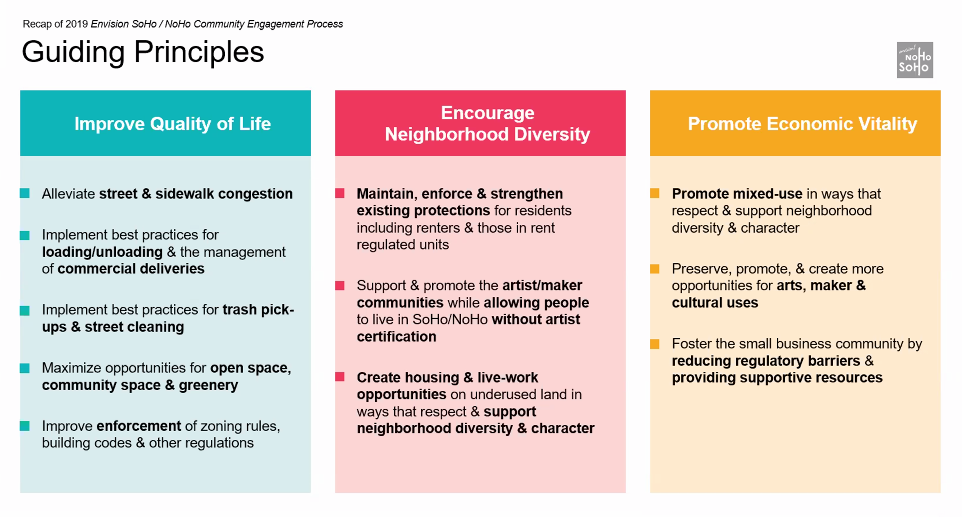
The planners alternated between taking questions over Zoom — in which the questioners spoke into their microphone — and written questions that people sent them.
“Why can’t we wait till COVID is over and have real public meetings?” wrote one frustrated audience member in a question that the planners read aloud. “Isn’t the Department of City Planning controlling this [meeting] completely and controlling what questions are asked?”
However, Botsford answered that the Soho/Noho rezoning was critically needed for the city to rebound from the pandemic.
“To not move forward, to wait until there’s a vaccine could really affect the city’s ability to recover,” Botsford maintained.
Other speakers who supported the plan, though, hailed the virtual meeting format, saying it was a great model to use going forward. Some of these individuals appeared to live outside the neighborhood, however.
One speaker who praised the proposal, Casey Berkovitz, is a communications rep for the Century Foundation, a progressive think tank.
“Soho can underwrite deeper levels of affordability,” he said, with a knowing chuckle, implying that the neighborhood’s residents are extremely wealthy.
Several other speakers who work in public affairs were also coincidentally picked to speak at the meeting, including at least one member of Open New York, Kyle Dontoh.
Open New York members typically showed up at the Soho/Noho Envision community meetings to strongly advocate for the city’s rezoning plan. Open New York is dismissed and jeered at by Soho and Noho residents as a front for developers, though the group denies it. Connie Murray, a Long Island City-based writer who blogs as Fuelgrannie, has written a revealing exposé about the group.
Chris Marte, who is running for Lower Manhattan’s City Council District 1, in a spoken question, warned that that “the Soho/Noho rezoning would create displacement potentially on the Lower East Side and Chinatown.”
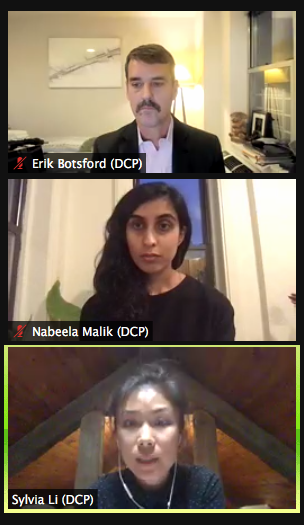
The City Planning members outlined the rezoning process
and moderated the meeting.
Botsford called Marte’s point “excellent” and said displacement would be studied as part of the environmental analysis.
The planners lauded Soho and Noho as a “high-opportunity area” since the districts are well served by transportation and near job centers.
A representative of State Senator Brian Kavanagh, noting that many of the area’s office building’s are currently empty due to COVID, asked why they can’t simply be converted to residential use.
However, Botsford answered, “These neighborhoods are vitally important job centers now. We want those uses to continue. … That balance is vitally important.”
Speaking afterward, Pete Davies, of the Broadway Residents Committee, who is a member of the rezoning advisory group, said the process is clearly being rushed now.
“The Department of City Planning reps as much as admitted tonight that they have not done any of the necessary work outlined in the final pages of the November 2019 Recommendations… (‘Next Steps and areas for additional study and analysis’).
“So Planning can hardly be ready to move forward, as they are scrambling to do now. But what choice do they have when given orders by de Mayor (who must be desperate for numbers to fill his measly MIH column, after losing so badly at Industry City, and seeing a year of lame-duckness looming before him)? It will be interesting to see if anyone wants to stand by him on this — or anything else — as his final year closes in on him.
“Senator Hoylman said it best when he pointed to the failure of de Mayor’s MIH schemes,” Davies added. “Market-driven investor (donor?) games, which (if ever built) would result in an even greater divide than there is now? Is that the best we can do?”
Sean Sweeney, director of the Soho Alliance, decried the virtual meeting a “farce.”
“It was like Big Brother on a giant TV screen and the rest of us proles invisible,” he said, indignantly. “The sponsors decided whose questions to answer and which to dodge.
“For instance, they ignored my question, the most obvious one: Since Mandatory Inclusionary Housing was never mentioned once during last year’s Envision Soho/Noho meetings, why all of a sudden is it the main focus now?
“Zoom meetings remove energy and the hands-on experience that an in-person meeting provides,” Sweeney charged. “Notice that the people who like the Zoom meetings were those who are not from Soho. In other words, they could influence what happens in our neighborhood from the comfort of their armchairs in Brooklyn.
“On the other hand, it was the locals who want real, spontaneous and true public meetings,” the Soho activist said. “A Zoom meeting is not a public meeting.
“It’s like de Blasio has taken advantage of COVID in order to dilute the energy of the community and to shape and control 100 percent the outcome of this process.”
Andrew Berman, director of Village Preservation, also voiced concerns about the rezoning plan in comments during the meeting. Afterward, he gave a statement to The Village Sun.
“There is a frustrating lack of detail provided so far, but there are enough indications to cause serious concern,” he told the paper. “We know the city wants to upzone a substantial portion of the neighborhood, which would result in even larger development than the 60-plus buildings already constructed in these two small neighborhoods in the last several years.
“We know they want to make it easier for big-box chain retail stores to locate here, too, while small independent businesses are suffering unprecedented hardships.
“The one positive indication,” Berman said, “was the potential application of contextual zoning — but without any details about what height limits would be included, that’s a meaningless announcement.
“We noticed that the proposed rezoning area has also been rolled back slightly on the west side, which is good. But we also know that big real estate interests have been behind this push and this process, and that major donors to the mayor’s campaign and now-shuttered nonprofit, like Edison Properties, are being rewarded with upzonings for their development sites.
“The city promised that there would be no movement on this process without engaging the community advisory board,” Berman added. “In fact, the board hasn’t met in nearly a year, and the city just sprung this October surprise upon all of us. There was great distrust of this process from the beginning; it seems those fears were well-founded.”
By Nolan Hicks and Bernadette Hogan October 28, 2020

New York state Sen. Brad Holyman (D-Manhattan)
Who’d have thought a city zoning plan would be compared to a Supreme Court nomination!
Still, one state lawmaker made the comparison during a Department of City Planning meeting this week about Mayor Bill de Blasio’s controversial plans to add thousands of new apartments to Manhattan’s posh Soho and Noho neighborhoods.
“This is the Amy Coney Barrett of rezoning proposals,” said state Sen. Brad Hoylman (D-Manhattan), who likened the timing of the proposal to congressional Democrats’ gripes about President Trump’s late fourth-year appointment to replace the late Ruth Bader Ginsburg.
He said the plan should be paused until de Blasio’s successor — the term-limited mayor has just one year left in office — takes over in January 2022.
“Frankly, under the cloud of COVID, I don’t think appropriate public policy decisions are going to be made,” Hoylman argued.
The proposal would allow developers to build up to 3,200 new apartments. A quarter of the units would have their rents regulated and be set aside for middle or working-class New Yorkers under city rules.
It would also remove the special permitting requirements that had built up over the years in the two one-time industrial neighborhoods, including provisions that required some residents to register as artists to qualify to live in the area.
The proposal is backed by neighborhood Councilwoman Margaret Chin and Manhattan Borough President Gale Brewer, both of whom must also leave their posts in 2021 due to term limits.
Hoylman offered a litany of complaints about the plan in a subsequent interview with The Post — claiming the zoning changes would allow buildings that are too big and would not provide enough affordable housing.
He also argued that City Hall should not allow developers to apply for incentives in exchange for putting additional units under rent regulation.
“I think 800 units isn’t enough especially when it threatens the scale of one of the world’s most iconic neighborhoods,” added Hoylman, who is running to replace Brewer. “Context is going to be key — and we need to plan from the ground up rather than dropping a fully baked pie from the sky.”
Hoylman’s broadside infuriated housing activists, who have been pressing City Hall to add housing to Manhattan’s core for years.
“I gasped, that’s not an exaggeration,” said Amelia Josephson, a board member of the pro-housing group Open New York, who attended the virtual meeting. “The senator made an ignorant comment, comparing the long list of economic and racial justice groups behind it to an extremist who threatens New Yorkers rights.”
A city official was even blunter, calling Hoylman’s remarks “a lot of bulls–t.”
“We’ve been working on this for a year and a half, this isn’t, ‘There are 43 days left in the administration’,” the person added. “It’s hardly out of left field.”
Like Hoylman, preservationists and anti-development activists contend the rezoning will result in buildings that are too large for the neighborhoods and would fail to provide enough affordable housing — and the changes would likely benefit a large de Blasio donor.
The reason why is easily found on a map. Many Soho and Noho blocks are protected from any future development under the city’s preservation laws, which means new construction would be focused on the empty spaces in the neighborhoods — including two parking lots owned by de Blasio-linked Edison Properties.
The company’s former chairman Jerome Gottesman — now deceased — and retired CEO Steve Nislick gave tens of thousands of dollars to Hizzoner’s campaigns and the scandal-scarred nonprofit he ran, the Campaign for One New York.
The preservationists and anti-development activists also contend that de Blasio’s decision to push ahead earlier this month was driven by politics.
The mayor announced the move as he came under fire for bowing to quality of life complaints from Upper West Side residents, who were upset about the relocation of hundreds of homeless New Yorkers from shelters to local hotels to stop the spread of the coronavirus.
“It’s a dumb political thing,” conceded a former administration official. “Residents feel like the mayor’s doing it to make a political point — and you know what, he is.”
City Hall press secretary Bill Neidhardt rejected the criticisms, saying the plan would help open up one of the city’s poshest neighborhoods where the average asking price for rent remains above $4,000 a month even amidst the coronavirus pandemic.
“Soho and Noho have changed quite a bit, and it’s time for thoughtful, progressive zoning changes,” Neidhardt added. “City Hall is committed to making these iconic neighborhoods more accessible than ever.”
NEW YORK (CBSNewYork) – More affordable housing could be coming to the SoHo–NoHo area,
A proposal backed by Mayor Bill de Blasio would change zoning laws to allow for new development.
CBS2’s Aundrea Cline-Thomas explains what it means, and why some residents are ready for a fight.
NEW YORK (CBSNewYork) – More affordable housing could be coming to the SoHo–NoHo area,
CBS2’s Aundrea Cline-Thomas explains what it means, and why some residents are ready for a fight.
SoHo and NoHo have transformed from a manufacturing hub to one for upscale destination retail. Known for its spacious loft apartments, Sean Sweeney of the SoHo Alliance moved in when it was less desirable in 1981.
“We pioneered a neighborhood out of the urban wilderness. Slowly and surely it got more popular and we were all paying cheep rents,” Sweeney said.
Those days are over, with newcomers shelling out top dollar. But under a new rezoning plan backed by the mayor, that could change.
“There needs to be affordable housing in every community, including those that are upper income,” de Blasio said.
Under the proposal, as many as 3,200 new homes could be created. According to the city, roughly 800 would be affordable units.
“Not only will this help with housing and affordable housing, it will help with jobs. It will help with economic activity,” said Moses Gates of the Regional Plan Association.
Gates says the city has outgrown the industrial zoning laws that were last modified in the ’70s, not properly serving those who really need the affordable units.
“It should be for the poor, the working class, even for people in NYCHA even the people in these hotels. They should be the ones getting this housing, not the upper middle class,” Sweeney said.
Add to that concerns about the possibility of new development towering over existing buildings.
“If de Blasio is looking for a knife fight he’s going to get it. We want something reasonable. Not something he’s imposing on us,” Sweeney said.
It’s proximity to transit and retail make it prime real estate. For decades, the city left it alone – until now.
The plan is a long way from being finalized. The public review process will begin later this month.
by Sean Sweeney October 6, 2020
Soho’s working-class residents suffer the worst consequences of reckless rioting in the neighborhood.
Bonnie* is a retired teacher who now sells her art on Prince Street near her rent-stabilized apartment in Soho. She is not the kind of trust-funder, rich celebrity or wealthy CEO most people assume live in Soho.
During the third calamitous night of looting in Soho on Monday, Bonnie looked out her window to see a dozen men uniformly dressed in black camouflage burst into a luxury retailer on the ground floor of her building. A moment later, in a well-orchestrated maneuver, a $330,000 Rolls-Royce SUV pulled upand the looters piled their booty into the car, which then drove away with the spoils of war.
And war it was. Not a peaceful protest over the killing of a black man. Not anger at brutal cops. Not outrage at the social injustice endemic in our society.
It was a war zone in Soho, with trash cans burning and arsonists setting dumpsters ablaze, 20 feet from the home of an ordinary family. It was a violent riot with scores of people running amok, indiscriminately smashing the windows of high-end retailers as well as our local bodega. They broke into a mom-and-pop sandwich shop, stealing five bicycles the immigrant deliverymen use. As a result, these poor hardworking folk can no longer do their jobs.
The working- and middle-class people of Soho have had to remain in place to face the COVID virus. They have no second homes to retreat to. Now they are faced with the virus of organized criminal gangs.
And yet, on the social media site Nextdoor.com, many commenters had little sympathy for the people of Soho. We were branded as rich white elitists who cared nothing about suffering black people. They believe the urban myth hyped by The New York Times’ Style section that artists no longer live in Soho, that it is only the home of gazillionaires.
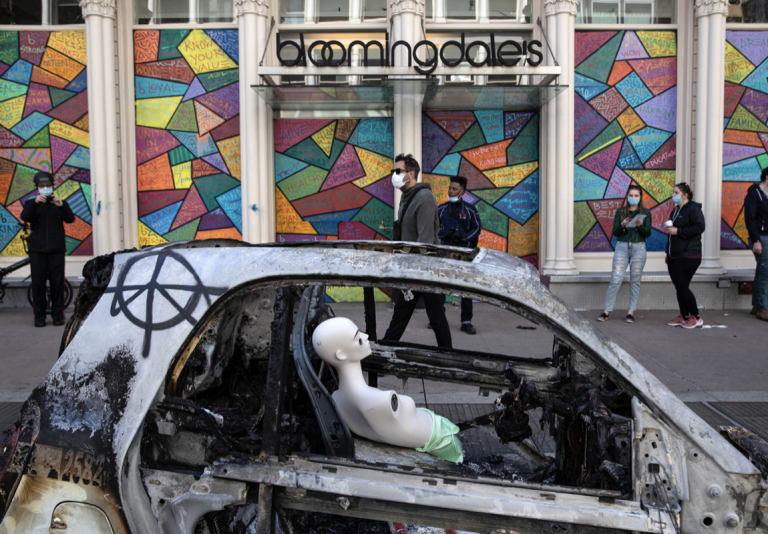
A burned-out police vehicle sits in Soho after the riots, which felt more like war than a protest.
Getty Images
I know this myth to be false because for 25 years I have served as director of the SoHo Alliance, a volunteer community group founded in 1981 that looks out for the needs of Soho’s 8,000 residents.
Yes, some locals reside in lofts with a median sales price of $2.5 million. But many of my neighbors are pioneers living in rent-stabilized lofts or co-ops purchased for a pittance back in the day: artists, writers, filmmakers, playwrights, even the occasional fireman and electrician.
On a Nextdoor.com post entitled “Looting in SoHo,” in which my neighbors bemoaned the destruction of our streets, one woman spontaneously chimed in that Soho residents can “buy safety” and “count the justice system being on our side” with our “privileges.” When I exhorted my neighbors not to feed the troll, another woman on the same platform accused me of “anti-black racism.”
Little do they know about me or my neighbors.
Currently I am the super of a co-op building two artist friends and I purchased in 1981 with buy-out money after a prior landlord paid us to end our rent strike when he tried to evict us from our $300-a-month loft.
Politically, I was your typical 1960s political radical. I marched in countless protests. In 1968, police maced me at the Democratic Convention. From 1973 to 1991, I worked at The Loft, the legendary after-hours private dance party on Prince Street, whose members were 85 percent queer people of color.
So it galls me to hear strangers who stereotype, berate and belittle us, insinuating we are rich, white, privileged crypto-racists for calling 911 in desperation, requesting police protection from the organized criminal gangs who invaded our community.
Worse, some actually defended the looting, rationalizing it as payback for the injustices blacks have had to endure and forgetting the peaceful message of Martin Luther King Jr.
Looting will never foster social justice or redress past grievances. Looting only serves to selfishly benefit the looter and promote reactionary politics.
Although the demonstrations in the 1960s were massive, they were almost exclusively peaceful. That changed after the Chicago police riot, when a splinter group of the Students for a Democratic Society, the Weather Underground, began a campaign of violence in October 1969.
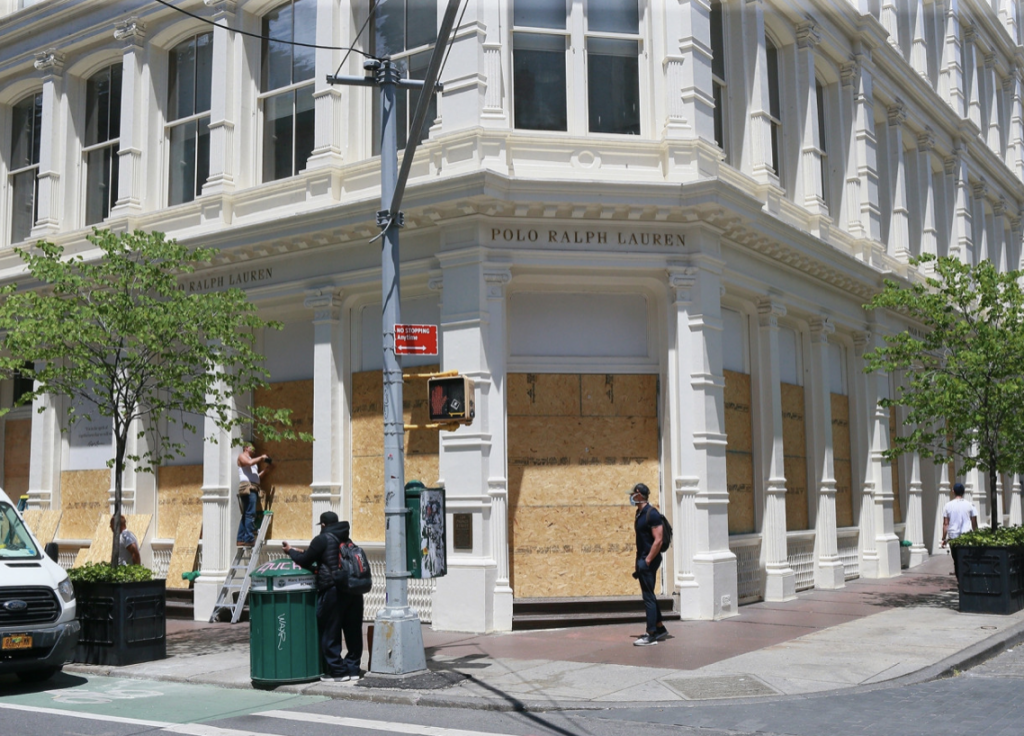
While Soho is famous for its high-end shops, it is also peopled with artists, families and essential workers living in hundreds of rent-stabilized apartments.
T.JACKSON / BACKGRID
Many of the right successfully used this minority’s actions to claim the entire anti-war cause was fueled by nothing but violent extremists. A month later, this enabled President Nixon to win the support of what he called the “Silent Majority,” who helped elect him in a landslide.
The same can happen in 2020. Although Trump is no Nixon, if this looting and violence continues, the president could use it to muster the current Silent Majority to his side and win in November.
Is that what these born-again radicals really want?
Sean Sweeney is the director of the SoHo Alliance. Bonnie requested that her last name be withheld from this piece.

LOWER MANHATTAN — Mayor Bill de Blasio revealed his vision to re-zone the Lower Manhattan neighborhoods of NoHo and SoHo, clearing the way for more retail and as many as 800 affordable housing units.
“SoHo, NoHo you’re talking about an area that has very little affordable housing,” the Mayor explained “We have an opportunity here to create affordable housing to bring to an area that has been upper income, a greater mix of New Yorkers, and create more balance, which is something I believe in fundamentally.”
Citizens Housing Planning Council praised the initiative. Executive Director Jessica Katz told PIX11 News she believes the announcement is “City Hall saying that they are willing to put the same amount of energy into rezoning a wealthy largely white high income neighborhood in central Manhattan, with the same kind of fervor that they were, that they were looking to apply towards housing in other neighborhoods.”
Longtime resident and SoHo Alliance Director Sean Sweeney explained “we want affordable housing, but we don’t want affordable housing the way that de Blasio has been positioning it.”
“They would be 75%, super luxury condos with a small amount of affordable housing set aside,” Andrew Berman of Village Preservation said. “That’s not a great way to create affordable housing.”
A public forum will be held later this month to allow residents to voice their input on the mayor’s proposal.
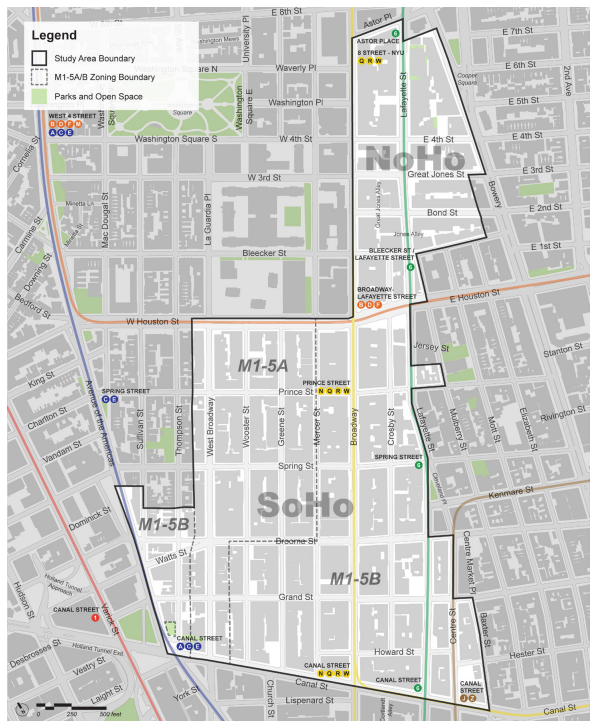
September 17, 2020
BY ANDREW BERMAN | The future of New York City seems more uncertain now than perhaps any time since the fiscal crisis of the 1970s. There’s massive unemployment, rampant homelessness, small business closures and a mass transit disaster looming. Amidst all of this, the unaffordability of too much housing for too many New Yorkers remains a vast, unresolved problem.
But a push by aligned real estate interests in favor of a large-scale upzoning of Soho and Noho takes a Trump-like approach to this challenge, while hiding the vested interests of those behind the push. Dishonestly, they gloss over neighbors’ true objections to the plan’s overscaled towers of largely luxury housing, claiming opponents are resisting affordable housing rather than new construction of a neighborhood-shattering scale.
Just before COVID hit, the city concluded a year-long process looking at a vast array of regulations governing these neighborhoods, to consider potential changes. Zoning and other rules for Soho and Noho are renowned for their complexity and, in many cases, date back decades to when these were very different places.
Those regulations were also notoriously unevenly enforced by the city, allowing those with means to sidestep the rules in various ways. No one — from longtime artist residents who built the neighborhood to newer wealthier largely non-artist residents, or from small store and property owners to the big-box chains and moneyed developers increasingly eying the neighborhood — was satisfied with the status quo.
But when business groups engineered the recent Soho/Noho “re-envisioning” process, many neighbors, including Village Preservation, pushed back, aware of this administration’s miserable track record on developer-driven, community-unfriendly rezonings. This latest campaign to use this process as a vehicle for a large-scale upzoning in the neighborhood — which the city claimed was never its intention — confirms the worst fears about the motivations behind the process.
Groups like CHPC (Citizens Housing Planning Council) — whose board consists of developers such as Edison Properties, which owns two of the largest development sites in Soho and Noho — claim both their upzoning push, and the opposition to it, are about affordable housing. Nothing could be further from the truth. (Read the recent report by CHPC here, which makes no mention of the vested interests and potential profits that would flow to members of their board if their recommendations were carried out).
I can only speak for the group I lead. We have consistently made clear that new affordable housing is welcome in our neighborhoods, including in Soho and Noho, even waging a letter writing campaign to city officials indicating so. And in dozens of meetings, I have never heard a single person object to increasing affordable housing in the neighborhood; if they have, they would certainly not get support for that cause from my organization.

What I have heard, however, and what we have amplified, is objections to increasing the size of allowable new development in the neighborhood by 250 percent, as is being proposed, to allow huge towers of 70 to 75 percent luxury housing and 25 to 30 percent affordable housing. For example, current zoning rules would allow a 100,000-square-foot building on CHPC board member Edison Properties’ parking lot in Noho. No new residential development is allowed “as of right” in either Soho or Noho, but can be granted through a variety of mechanisms. So, assuming an allowance for residential use were granted here within the size constraints currently in place for development in the area, 100,000 square feet of affordable housing could be produced — a dramatic infusion for this pricey neighborhood. Yet, Edison has expressed no interest in building affordable housing at this spot.
What CHPC’s plan would do instead is upzone the site to allow it to construct a quarter-million-square-foot development there — vastly larger than what’s currently allowed, and was allowed when Edison bought and paid for the property. Under its plan, utilizing the city’s Mandatory Inclusionary Housing provisions, such a development would include 175,000 to 187,500 square feet of super-luxury housing, and just 62,500 to 75,000 square feet of affordable housing — or significantly less than a purely affordable development built within the existing zoning limits for size of a new development here.
And if you think these current limits don’t allow sufficiently large new buildings in Soho and Noho, look at recent developments built under those limits at 210 Sullivan St., 27 Grand St. and 9 Crosby St. They are 210, 258 and 311 feet tall, respectively; upzoning advocates want new development two and half times that size.
Soho and Noho residents — especially longtime ones who helped build these neighborhoods from semi-abandoned and sometimes dangerous wastelands — care deeply about the character of their neighborhoods, and want new development to match rather than overwhelm it. I would posit that a well-designed affordable housing development that fits the existing size limits for new development in our neighborhoods would be welcome at that parking lot at Lafayette and Great Jones Sts. in Noho.
But whether it’s there, or Edison’s other lot at Centre and Hester Sts., or many other underbuilt, potential development sites in the neighborhood, residents would and do object to massive, out-of-scale and out-of-character new towers. And this is especially so when such projects’ biggest consequence would simply be adding massive amounts of previously restricted super-luxury housing to the neighborhood, and granting a dramatic windfall to developers who are, in many cases, behind the rezoning push.
CHPC and some advocates have bought into the false dichotomy promulgated by real estate interests and the de Blasio administration that the only way to get new affordable housing in New York City is to grant massive bonuses to luxury and market-rate housing developers. These bonuses vastly increase the developers’ profits and the size of their new buildings, but require only a small payback of affordable housing in return.
This is not unlike the Trump 2017 tax cut, where the price for a small amount of relief for middle- and lower-class Americans was massive tax cuts for the richest Americans and big corporations, who reaped by far the majority of those benefits. The New York Post editorial board recently called upon Mayor de Blasio to move ahead with this kind of upzoning in Soho and Noho, telling you everything you need to know about the true thinking and interests behind such an approach.
We can and should do better. As we have already pointed out, existing mechanisms would allow the city to mandate the inclusion of affordable housing when manufacturing or commercial buildings in Soho and Noho are converted to residential use, which is the largest source of new housing in those neighborhoods. Like our rezoning plans for other parts of our neighborhood that would introduce or encourage affordable housing, this approach has been roundly ignored and rejected by the administration, and by groups like CHPC. Why? Seemingly because it doesn’t rely upon the massive windfall for the big real estate interests who are Mayor de Blasio’s biggest campaign donors, and among the members of CHPC’s board.
Berman is executive director of Village Preservation (formerly Greenwich Village Society for Historic Preservation).
This piece was first published in citylimits.org.
Gothamist
June 10, 2020
"Birdwatching Is Not A Crime": Boarded Up Storefronts Become Canvas For Street Artists
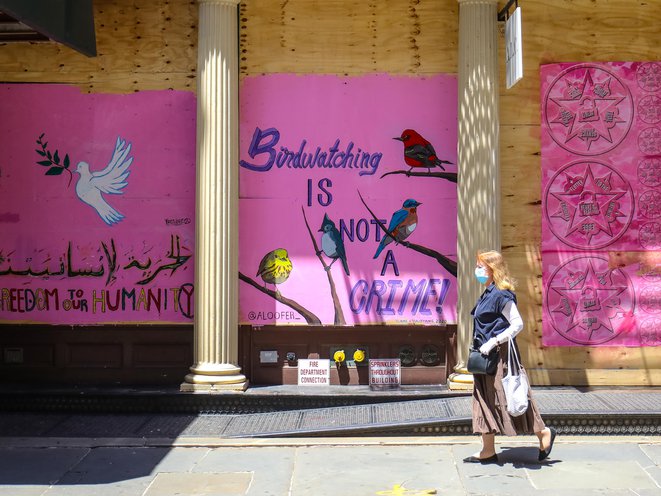
When the city was shutting down at the height of the pandemic in March, storefronts around SoHo began emptying out their spaces and/or putting their wares behind plywood. Then came the protests against racist police brutality at the end of May, and the concurrent glass-breaking and looting sprees that occurred early on, which forced businesses in several neighborhoods around the city to board up if they hadn’t already.
Of course, all that raw plywood makes for an inviting canvas, and today the streets of SoHo and Nolita are lined with all manner of rogue graffiti and sanctioned art — step back and you’ll see a collage capturing the moment, with pieces alternating between the pandemic and the protests. There’s even a mural reflecting the incident in Central Park, where a white woman, Amy Cooper, called the cops on a black birdwatcher, Christian Cooper.
While some are clearly unsanctioned, there are also a few murals by long-established street artists, like the portrait of George Floyd on Houston near Bowery by Fumero.

There’s also a coordinated art project in the works, with dozens of individual pieces on a wide range of subjects and varying degrees of expertise clustered around Greene and Broome Streets. The project is the brainchild of Tristan Reginato, a lifelong SoHo local whose dad has lived here since 1966, and Miriam Novalle, the founder of T Salon and neighborhood resident since 1972. Also involved in the effort is Bethany Halbreich and her nonprofit organization, Paint the World.
Working with the SoHo Alliance and with help from a $5,000 donation from Blick Art Materials, Reginato and Novalle will be here all week with what the latter called “artists from around the world” covering every panel of wood in the area. The primary message is “to end systemic racism,” said Reginato, but also “anything that evokes happiness, peace, and good vibes is encouraged.”
June 6, 2020
NY Post Op-Ed: SoHo Rioters Hurt Working-Class People
– Not Rich CEOs & Celebs
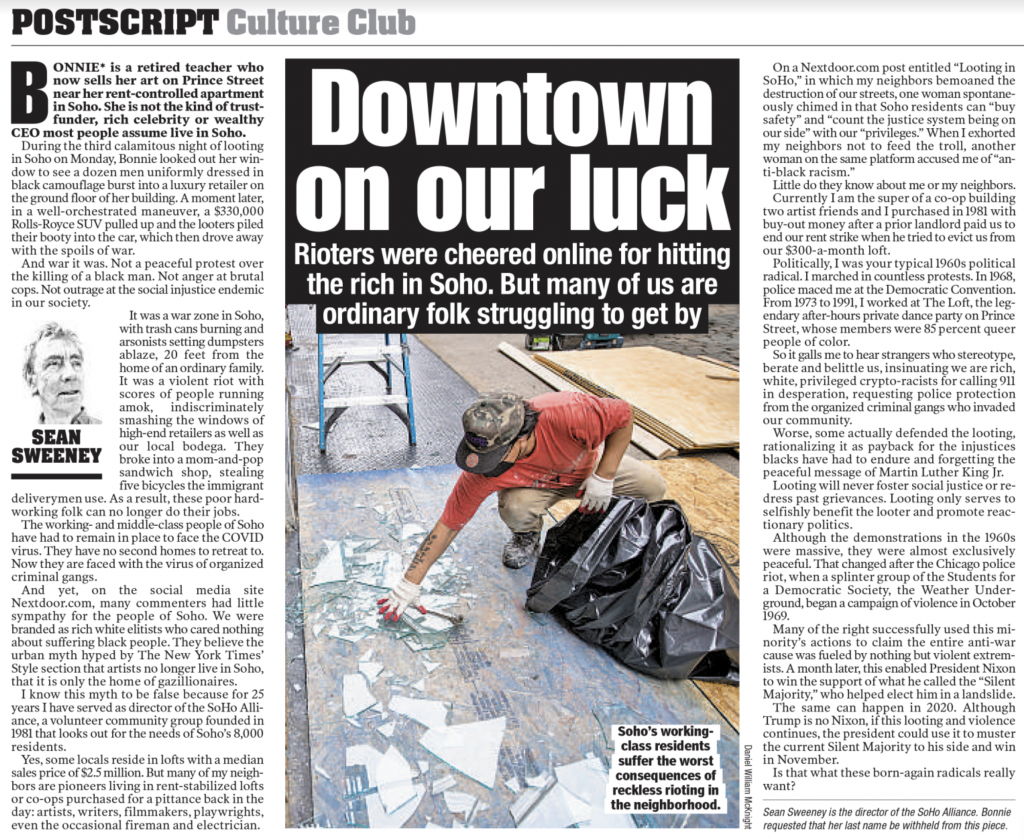
Conga Lines And Pot Banging Keep Soho Eatery’s Neighbors Awake
A SoHo spot hosting 10 birthday parties a night has to agree to stop conga lines and pot-and-pan banging to get its liquor license approved.
January 24, 2020
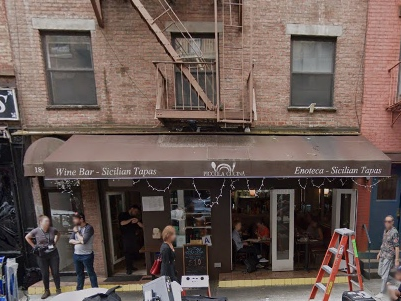
SOHO, MANHATTAN — An Italian restaurant that was banging on pots and pans and starting conga lines to celebrate as many as 10 birthdays a night has to stop disturbing neighbors in order to get a new liquor license, community board members said Thursday.
Piccola Cucina Enoteca on Prince Street, one of three locations of the Sicilian eatery in the neighborhood, was told in a unanimous vote by Community Board 2 that it won’t be allowed to have TVs, boozy brunches, conga lines or pot-and-pan banging celebrations if it wants a liquor license with longer weekend hours.
The vote comes after months of back-and-forth between the restaurant owners, the board’s Licensing Committee and neighbors who said the loud partying could be heard in nearby homes throughout the night.
“Many times a night they would have birthday celebrations, they would sing happy birthday and then they would all bang on pots and pans — literally,” committee member Susan Kent told the board. “Noise was the number one complaint.”
Neighbors told board members that the 184 Prince St. eatery was acting more like a lounge than a restaurant, hosting as many as 10 parties in one night and blasting music while patrons dance on tables and chairs and start conga lines with the windows kept wide open, minutes show.
Customers often spilled out onto the street, drinks still in hand, to table and chairs the restaurant set up on the sidewalk, even though they weren’t approved for a “sidewalk cafe,” neighbors said.
Owners, who told the board the complaints were exaggerated, would threaten neighbors if they approached them with these problems, the residents said.
Piccola did not immediately respond to a request for comment.
The board recommended denying the liquor license unless the owners added a list of 13 conditions to their application, including stopping the pot-and-pan banging, dancing, sidewalk drinking and only playing “quiet ambient recorded background music.”
The eatery had requested renewing its liquor license with an extra hour open each weekend night. Should the liquor license be approved, Piccola would be open from 8 a.m. to 11 p.m. Sunday through Thursday and 8 a.m. to 12 a.m. on Fridays and Saturdays.
Kent said the committee hoped adding in conditions for approval rather than outright denying the license would mean owners would be better neighbors at all three of Piccola’s locations in the area.
The Italian restaurant has outposts on Spring Street and Thompson Street, as well as a spot on the Upper East Side.
“The thought was that we would try to make them better operators — this same operator has two other licenses — the goal was to bring them in line and make them accountable,” she said. “We let them know we’d be paying attention.”
Acadia plows ahead with $122M retail investment in Soho
Acadia closed on 47 Greene Street in July for $25M
 47 Greene Street and President & CEO of Acadia Realty Trust Kenneth F. Bernstein
47 Greene Street and President & CEO of Acadia Realty Trust Kenneth F. BernsteinUPDATE, Monday, Oct. 28, 2019, 2:45 p.m.: Soho has been one of Manhattan’s more troubled retail corridors in recent years. But, anticipating a rebound, Acadia Realty Trust has been scooping up storefronts in the neighborhood, particularly along Greene Street.
In its third-quarter filing Thursday, the real estate investment trust said it had closed on another $25.1 million of its previously announced plans to acquire some $122 million worth of retail assets along Greene Street. The new acquisitions cover seven properties with an average remaining lease term of six years, one executive said on an earnings call this summer. Newmark Knight Frank’s Brian Segall and George Martinecz were the sole brokers on the transactions.
Earlier in the year, Rye, N.Y.-based Acadia said it planned to buy $97 million worth of retail assets in Soho. Acadia upped that commitment in July when it announced having picked up 47 Greene Street, a 7,200-square-foot property leased to fashion brand Theory, for $24.8 million in an off-market deal from seller EMP Capital Group. That comes out to nearly $3,450 per square foot.
In April, Premier Equities and Thor Equities sold the retail space at 51 Greene Street to Acadia for $14.6 million.
As of the end of the third quarter, $74.4 million of its under-contract deals — four contiguous buildings on Greene Street — have closed. Acadia said it expects the rest to close next year.
Acadia’s plan is to aggregate clusters of buildings “to curate these streets with the right mix of tenants. This creates a powerful portfolio,” president and CEO Kenneth Bernstein said during the company’s earnings call. “Additionally, we have found that when vacancies dry up, when scarcity and the rules of supply and demand kick in, well, rents grow.”
The retail play comes as New York’s retail market remains bifurcated, with some neighborhoods faring better than others as retailers grapple with waves of tenant bankruptcies and store closures.
An August report issued by the city found that the retail vacancy rate for Soho/Noho was higher than the city’s average of 11.6 percent. The city did not include Greene Street in its analysis of the neighborhood — it looked at Broadway, West Broadway and Broome, Lafayette, Mulberry, Prince, Houston and Spring streets — but found the vacancy along those streets to be 13.8 percent.
That’s not as bad as Canal Street’s 25.9 percent, though far from the top-performing neighborhood of Jackson Heights, where the rate was just 5.1 percent.
Another measure of retail real estate in Manhattan, brokerage firm CBRE’s third-quarter market report, also found that Soho was a challenged area for retail. Though CBRE, too, did not focus on Greene Street, the firm found that Broadway in Soho saw a 14.9 percent drop in asking rents in the third quarter from the quarter before, to $486 per square foot. That was the first time that rents had dipped below $500 per square foot since 2011.
Acadia reported net income of $31.7 million for the first nine months of the year. That’s up about 30 percent year over year. The occupancy rate for its portfolio was 93.5 percent, and the firm also reported inking leases at 154 Spring Street and 135 Prince Street, also in Soho.
A representative for Acadia did not immediately return a request for comment.
Prince St In SoHo Will Get Bike-Friendly Signal Timing
Traffic signals will be re-timed to help more cyclists ride ahead on Prince Street, Mayor Bill de Blasio announced.
By Sydney Pereira
Oct 24, 2019 7:00 am ET

SOHO, NY — Traffic lights will be re-timed to make it easier for cyclists to ride ahead along Prince Street in downtown Manhattan, city officials announced Wednesday.
Prince Street will get the “Green Wave” treatment in the next year to sync traffic lights so that they turn green for cyclists traveling 15 miles per hour — a safety treatment that has boosted bike traffic in Boerum Hill where the city’s Department of Transportation launched a pilot about a year ago.
“Vision Zero means making sure people on bikes in every neighborhood feel safe — whether they’re in Boerum Hill, Bath Beach or Bushwick,” Mayor Bill de Blasio said in a statement.
As cycling fatalities have reached more than two dozen so far this year, compared to 10 cyclist deaths in all of 2018, the “green wave” plan will expand the new signal timing to Prince Street in Manhattan, 43rd Avenue in Sunnyside, Queens, and Clinton Street in Brooklyn in the next year.
The signal timing will be coordinated with cyclists who bike about 15 miles per hour, down from signals’ current coordination with drivers going 25 miles per hour.
On Hoyt and Bond streets, bike volumes have increased, and though drivers have slowed slightly or remained the same speed, cars did not migrate to nearby streets, the mayor’s office said.
The announcement was made as city officials celebrated the 100th protected bike lane built during Blasio’s time as mayor.
“Through Vision Zero and the ‘green wave,’ this Administration has implemented and created key safety solutions — like the signal timing project in Boerum Hill — and outlined a blueprint for a citywide bike network,” said Deputy Mayor Laura Anglin.
COMMERCIAL OBSERVER
A Possible Rezoning Raises Questions About the Future of Soho
October 22, 2019
By Rebecca Baird-Remba
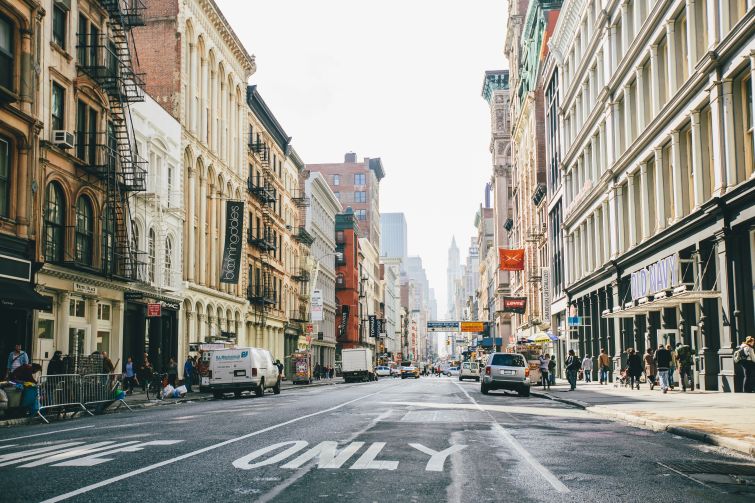 Landlords along Soho in Broadway are pushing for a rezoning that would allow them to legalize stores and residential uses. Photo: Getty Images
Landlords along Soho in Broadway are pushing for a rezoning that would allow them to legalize stores and residential uses. Photo: Getty Images
Soho and Noho are, in many ways, frozen in time. Retailers change, but the beautiful, landmarked, cast-iron and brick buildings remain the same.
AM NY
September 27,2019
‘The One with the Huge Illegal Signs’: Huge ‘Friends’ billboard in Soho gets city violation
BY GABE HERMAN | Could that “Friends” billboard in Soho be any bigger?
Apparently, the sign at 503 Broadway is more than big enough for some local residents, and for the Department of Buildings (DOB), which has issued violations for that sign and others that the pop-up has displayed in recent weeks.
The pop-up is currently in its month-long run, open through Oct. 6. It includes a retail store entrance at 503 Broadway and an entrance on the other side of the building, at 76 Mercer St., for an “immersive experience” that includes set recreations, props and costumes from the classic ‘90s sitcom.
Warner Bros. and Superfly, which organizes concerts and is doing another ‘90s sitcom pop-up in Manhattan for “Seinfeld,” opened up the Friends pop-up earlier this month.
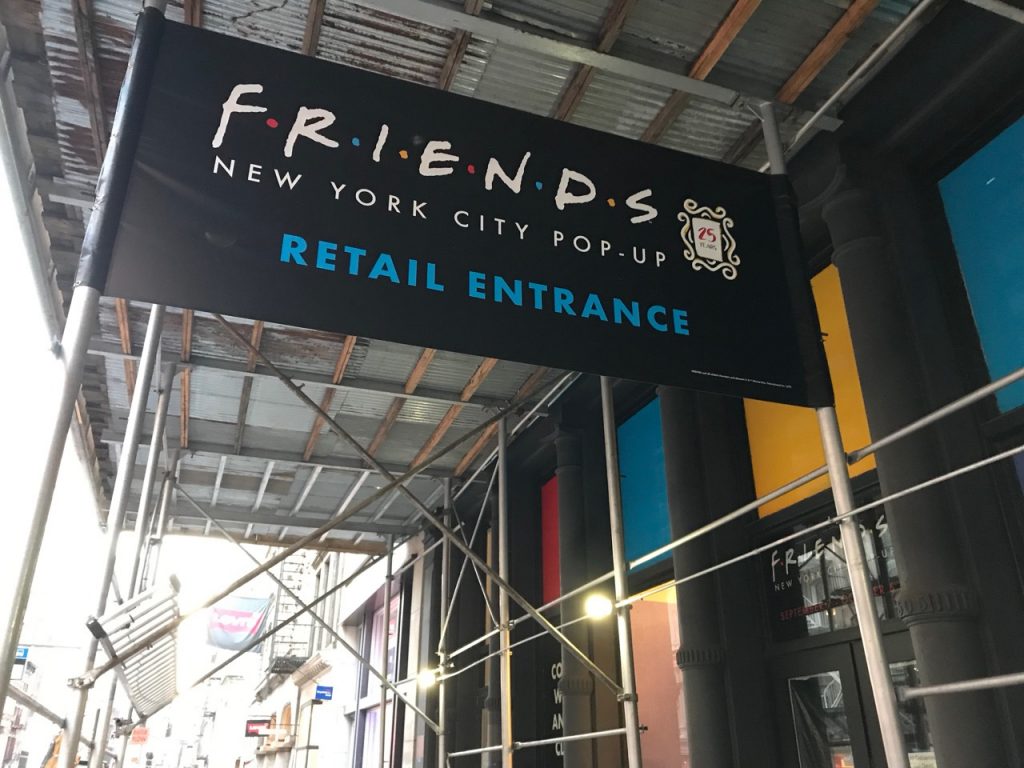
While crowds outside weren’t large as the pop-up opened in September, Sean Sweeney, director of the Soho Alliance, said he was not happy with the big sign on Broadway. “The humongous billboard on the scaffolding within an historic district is indeed a problem,” he said.
Pete Davies, a longtime Soho resident, remarked, “Perhaps this episode should be called: ‘The One with the Huge Illegal Signs.’”
DOB met with organizers of the “Friends” pop-up in August before the signs went up, according to a DOB spokesperson, to go over the Department’s guidelines.
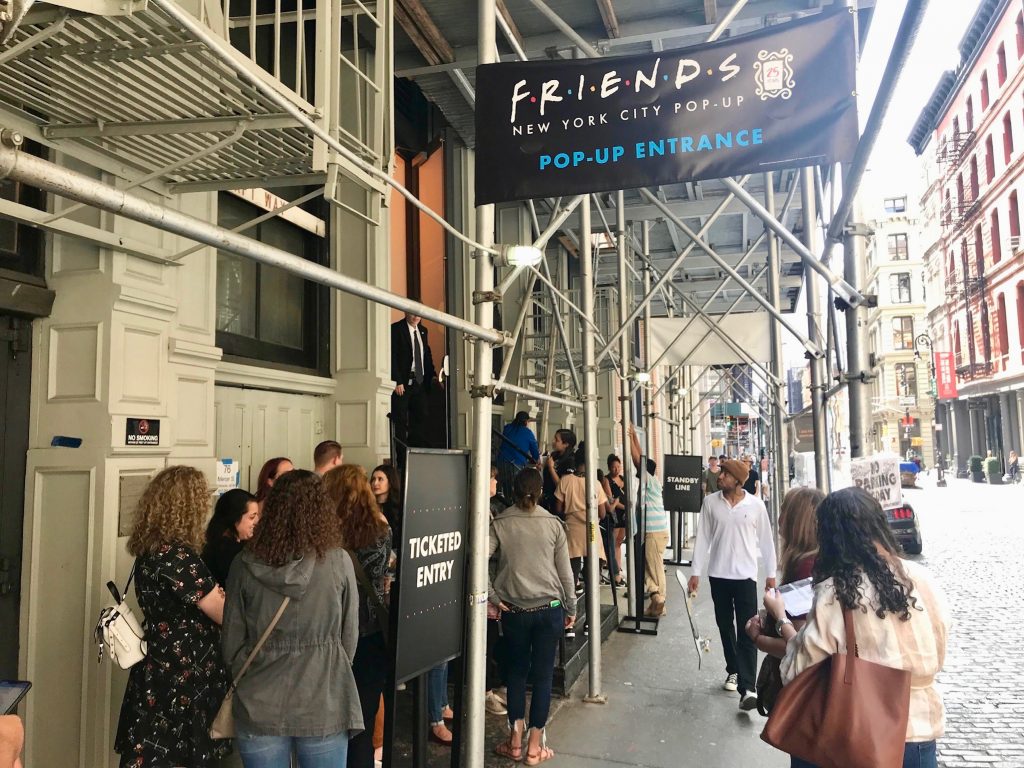
On Sept. 17, however, DOB inspectors went to 503 Broadway after a 311 complaint from a member of the public, the spokesperson said, and after concerns were expressed by local officials about illegal signs on the building.
“DOB’s investigation found that there were six illegal signs hung at the building,” the DOB rep said, “including several underneath the sidewalk shed outside the building, and an approximately 1,800 square feet sign hanging on the protective scaffold netting above,” referring to the large “Friends” billboard.
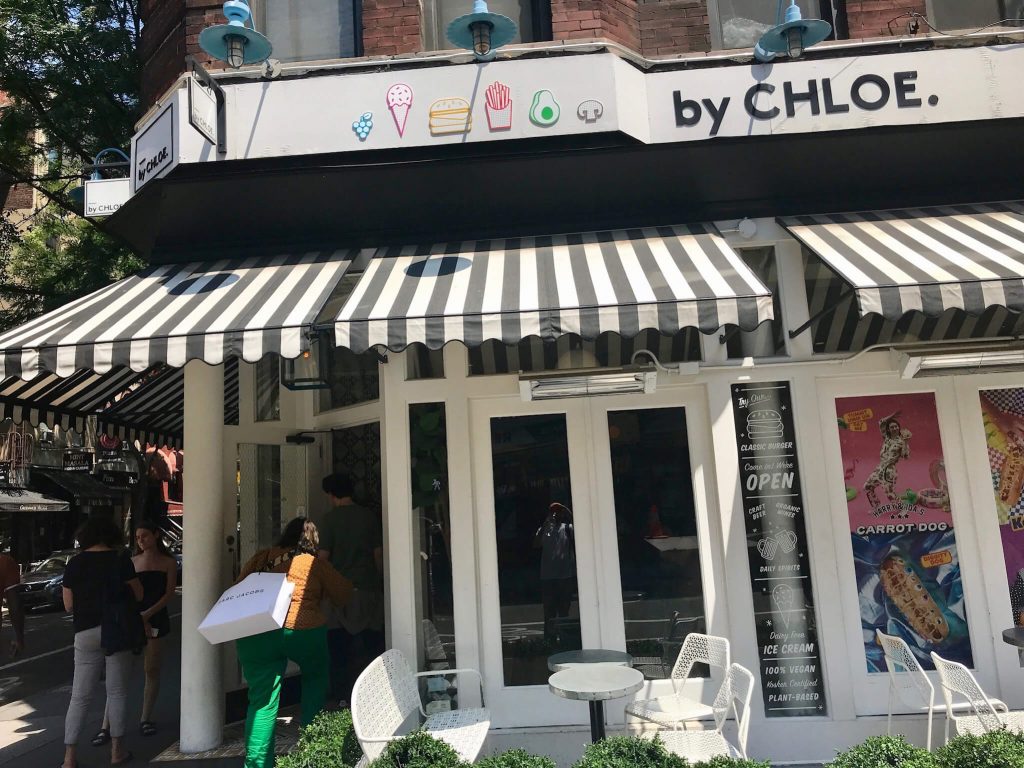
Four of the illegal signs were for the “Friends” event, while two others were for a Zara retail store, according to DOB.
Thirteen total violations were issued to the building owner, according to DOB, including for the huge billboard, which exceeded the allowable advertising surface area of 1,200 square feet in a manufacturing zone. There were also five violations for an outdoor advertising company sign on display without a permit, and three violations for an illegal sign hanging from the sidewalk shed.
A hearing date is being scheduled for the 13 violations at the Office of Administrative Trials and Hearings, according to DOB, and if the violations are upheld at the hearing, fines could total up to $100,000.
Organizers of the “Friends” pop-up event did not respond to a request for comment about the signs.



